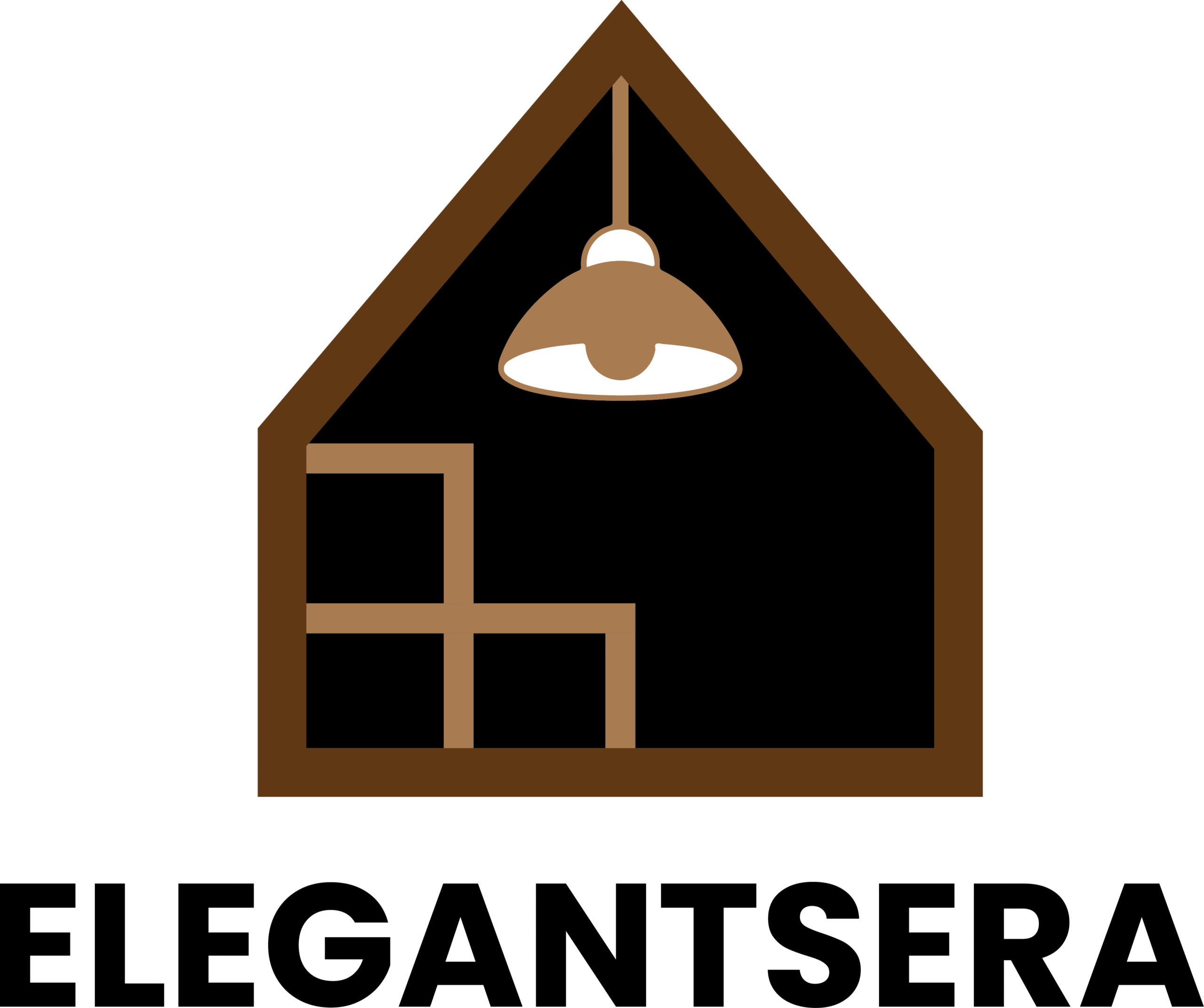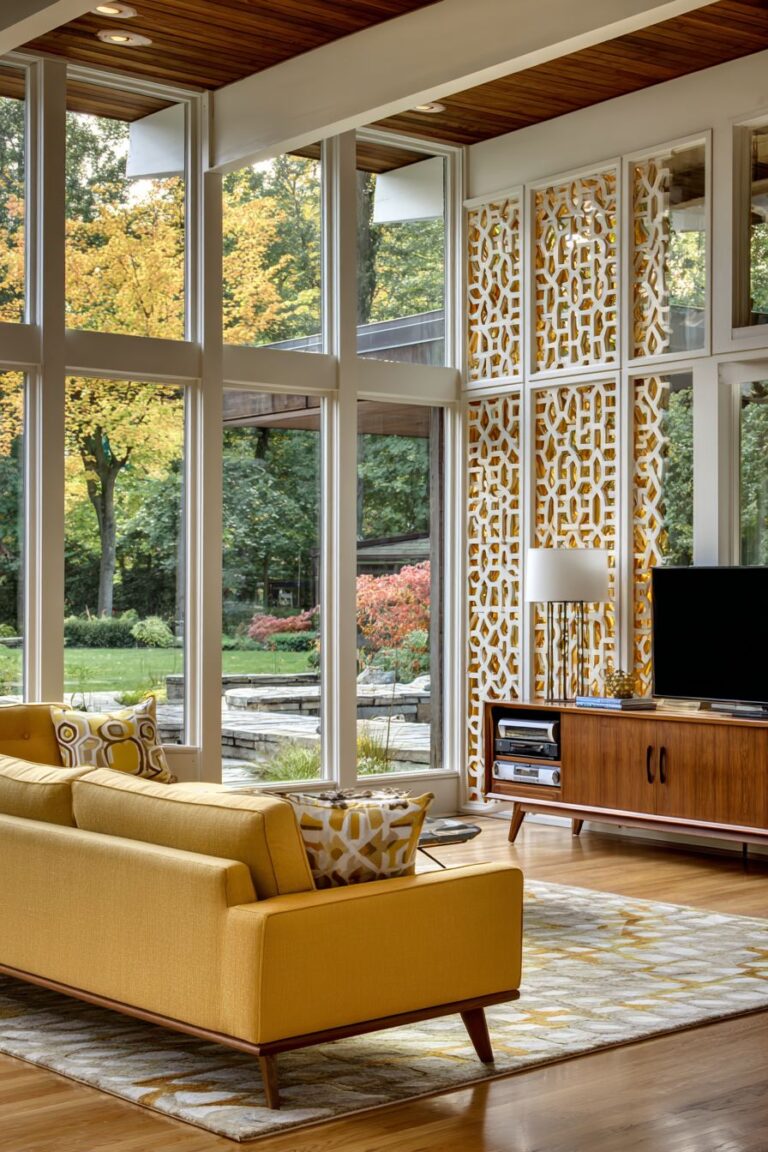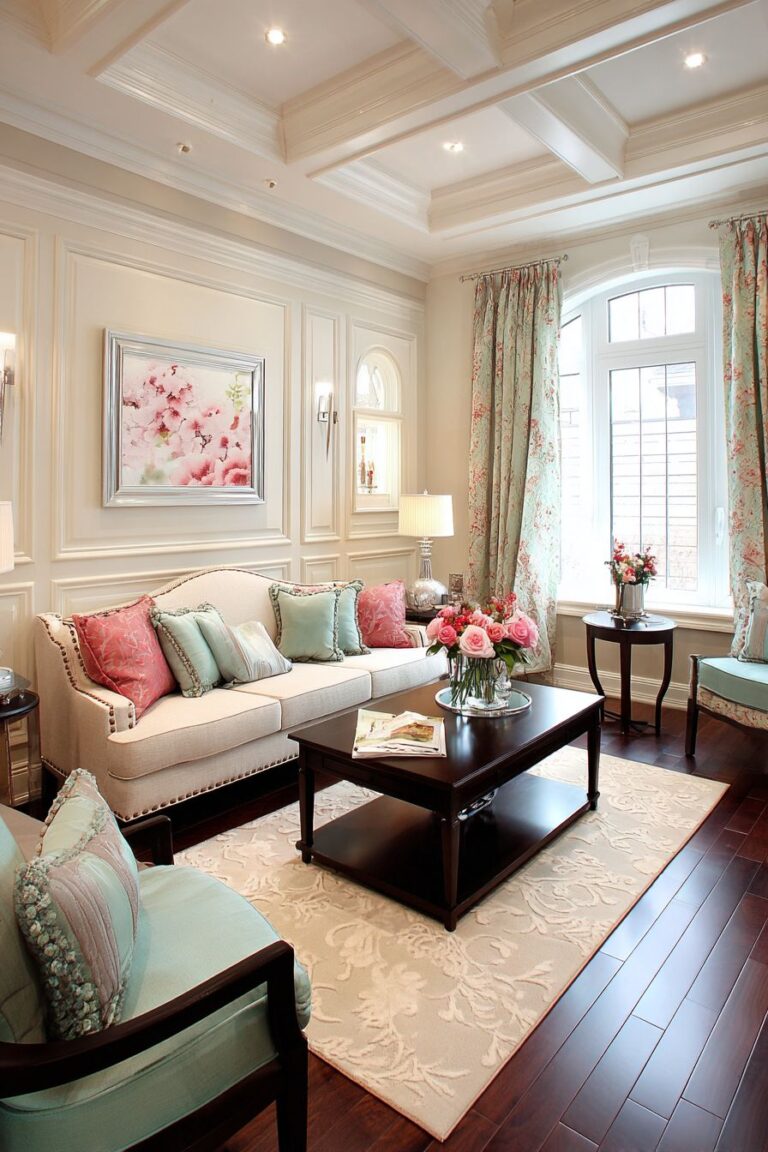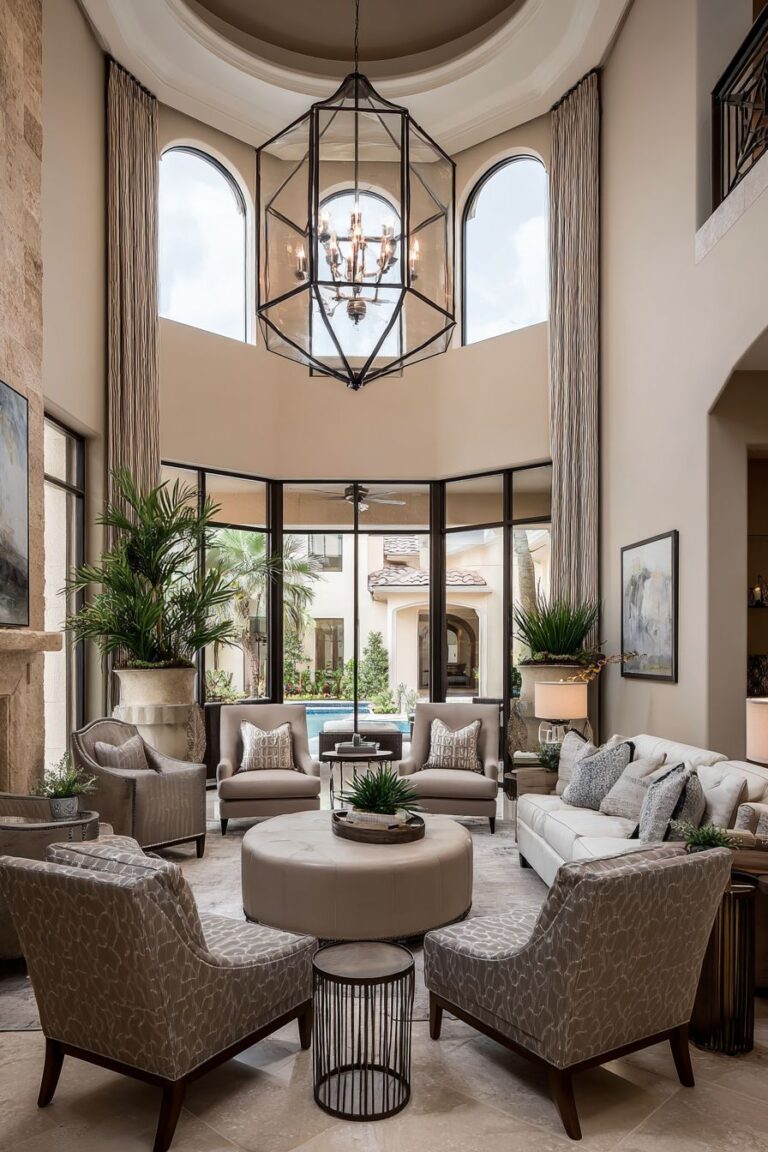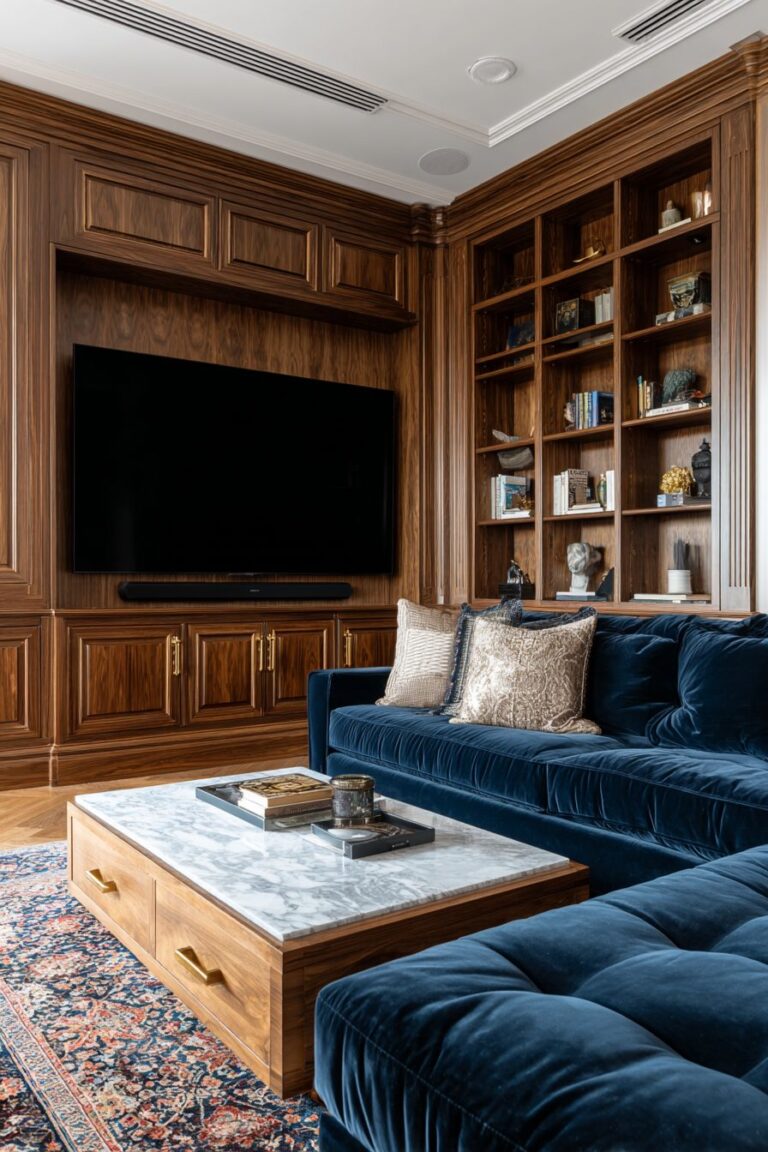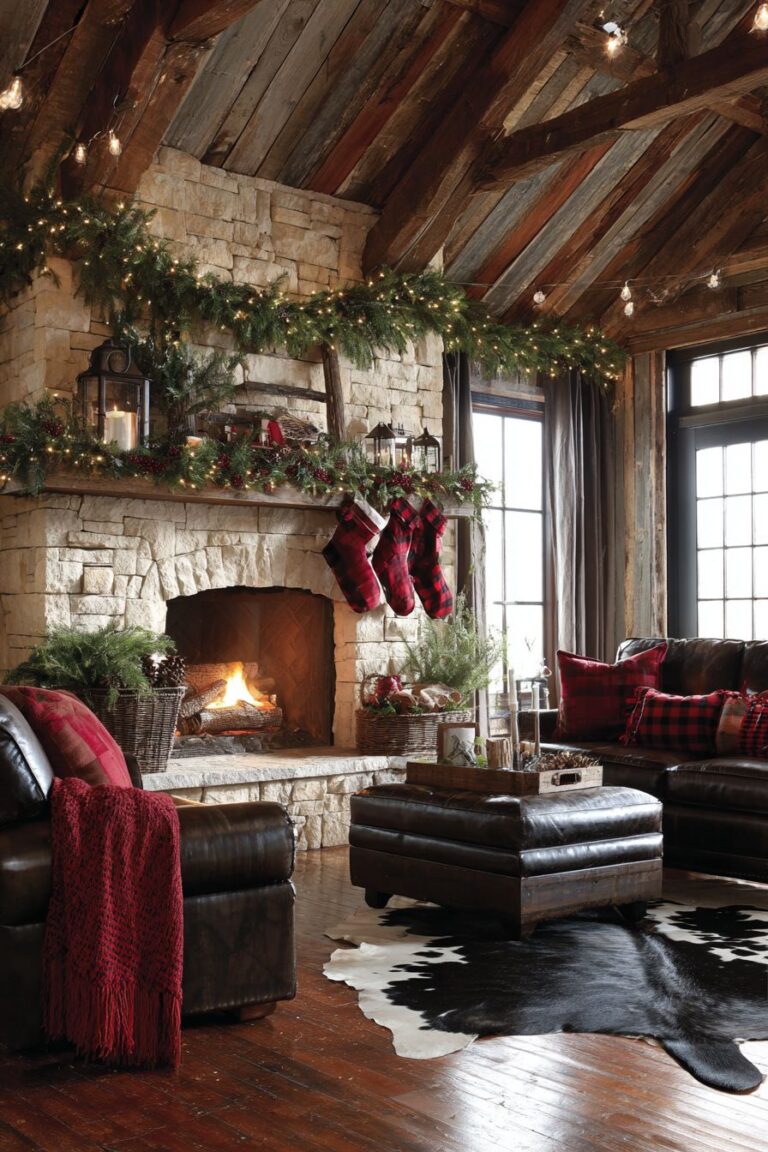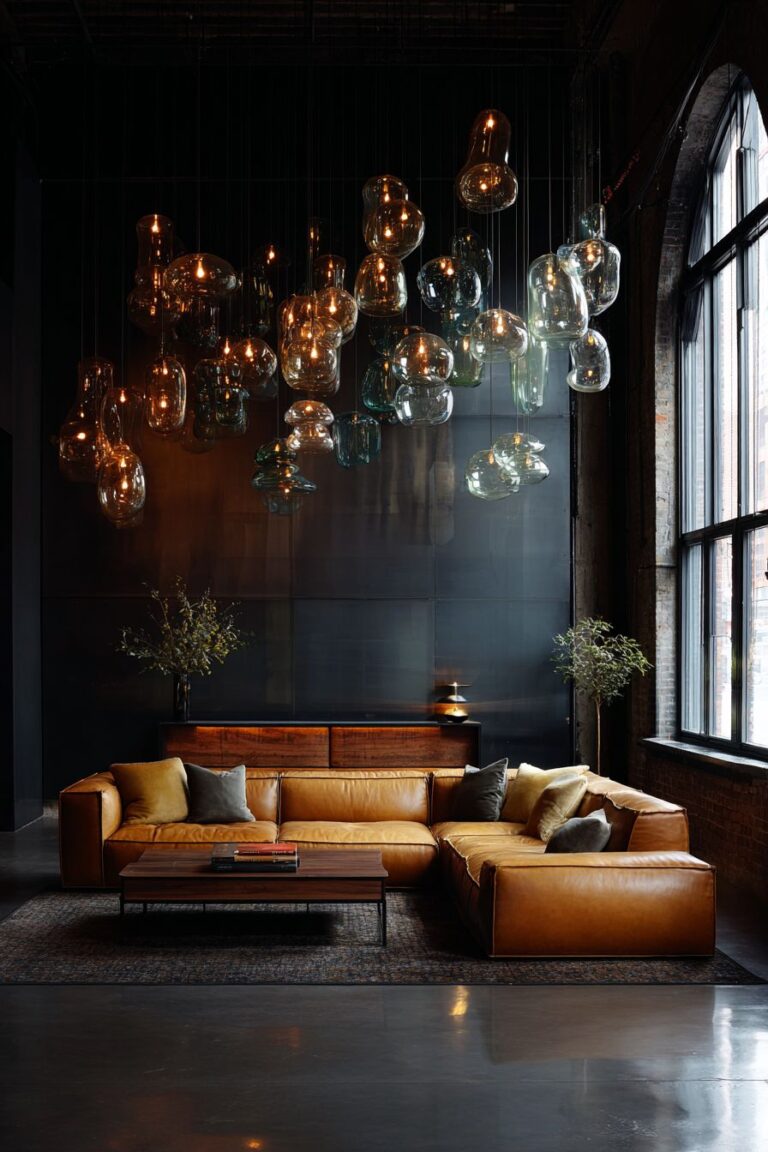20 Arabic Living Room Ideas: Capture Timeless Middle Eastern Elegance
The art of Arabic interior design represents centuries of cultural refinement, where every element tells a story of heritage, craftsmanship, and sophisticated living. In today’s modern homes, Arabic living rooms offer an enchanting escape from the ordinary, transforming everyday spaces into luxurious sanctuaries that celebrate the rich traditions of Middle Eastern design. These spaces masterfully blend ornate details with functional comfort, creating environments where hospitality and beauty coexist in perfect harmony.
Arabic living room design encompasses a diverse range of styles, from the nomadic influences of Bedouin culture to the palatial grandeur of Moorish architecture. Each approach brings its own unique character through carefully selected materials like hand-carved wood, intricate metalwork, sumptuous textiles, and artisanal ceramics. The beauty of Arabic design lies in its ability to create intimate spaces that feel both exotic and welcoming, incorporating elements such as geometric patterns, calligraphy, and traditional seating arrangements that encourage conversation and connection.
The following collection showcases twenty distinctive Arabic living room concepts, each offering unique insights into this magnificent design tradition. From traditional majlis arrangements to contemporary interpretations, these spaces demonstrate the versatility and enduring appeal of Middle Eastern aesthetics in modern home design.
1. Traditional Majlis with Burgundy and Gold Splendor

Step into a living room where tradition reigns supreme through the magnificent arrangement of a traditional majlis seating system. The space revolves around low-profile seating that follows the perimeter of the room, adorned with rich burgundy and gold brocade cushions that speak to centuries of textile craftsmanship. Each cushion tells a story through its intricate patterns, creating a tapestry of color and texture that immediately captures attention and invites lingering conversations.
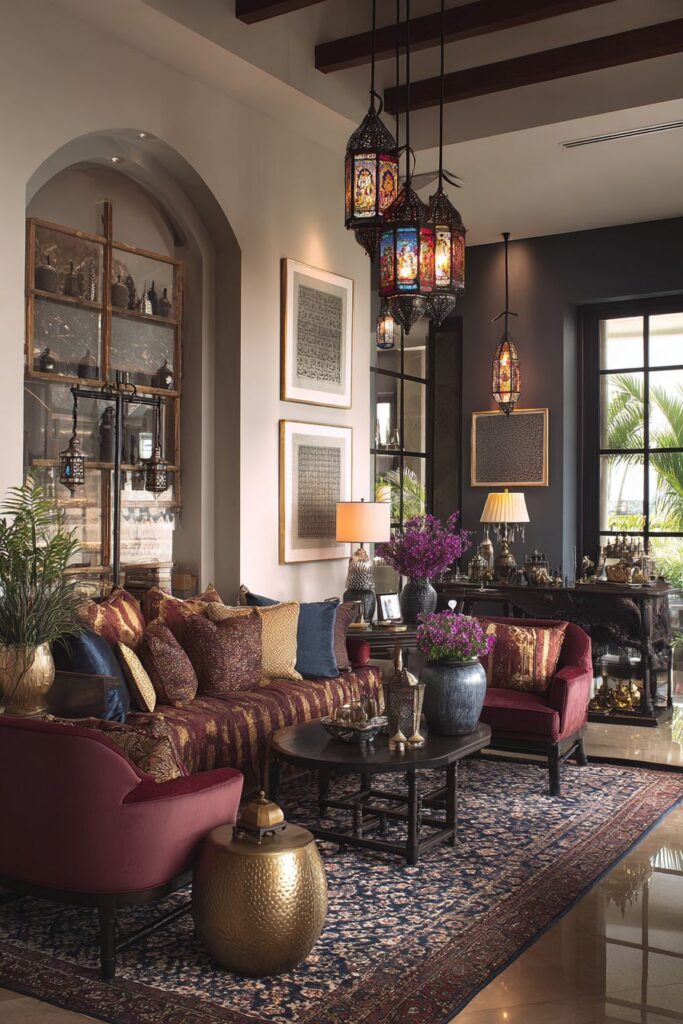
The foundation of this design lies in the exquisite hand-woven Persian rug that anchors the space with ornate geometric patterns in deep blues and golds. This masterpiece of textile art serves not merely as floor covering but as a canvas that unifies all elements within the room. The interplay between the rug’s sophisticated patterns and the brocade cushions creates a visual symphony that celebrates the mathematical precision inherent in Islamic art.

Overhead, intricate brass lanterns with colored glass panels suspend gracefully from the ceiling, casting warm ambient light that transforms throughout the day. These luminous jewels create an ever-changing atmosphere, their colored glass filtering light into rainbow spectrums that dance across the metallic threads of the textiles below. The walls showcase traditional Arabic calligraphy artwork in elegant frames, each piece carefully selected to complement the overall color scheme while adding layers of cultural significance.
The magic of this space emerges through the careful balance of luxury and authenticity, where every element has been chosen to support the others in creating a cohesive whole. Professional interior photography captures these authentic cultural elements through soft natural lighting that highlights the luxurious textures and metallic accents, revealing how traditional design principles continue to create spaces of extraordinary beauty and functionality.

Key Design Tips:
- Position majlis seating around the room’s perimeter to encourage group conversation and maintain traditional social dynamics
- Layer rich brocade cushions in complementary colors to create depth and visual interest
- Choose hand-woven Persian rugs with geometric patterns as foundation pieces that tie together all design elements
- Install brass lanterns with colored glass to provide warm, filtered lighting that enhances textile colors
- Display Arabic calligraphy as both art and cultural expression, selecting pieces that complement your color palette
2. Mashrabiya Wooden Screen Elegance
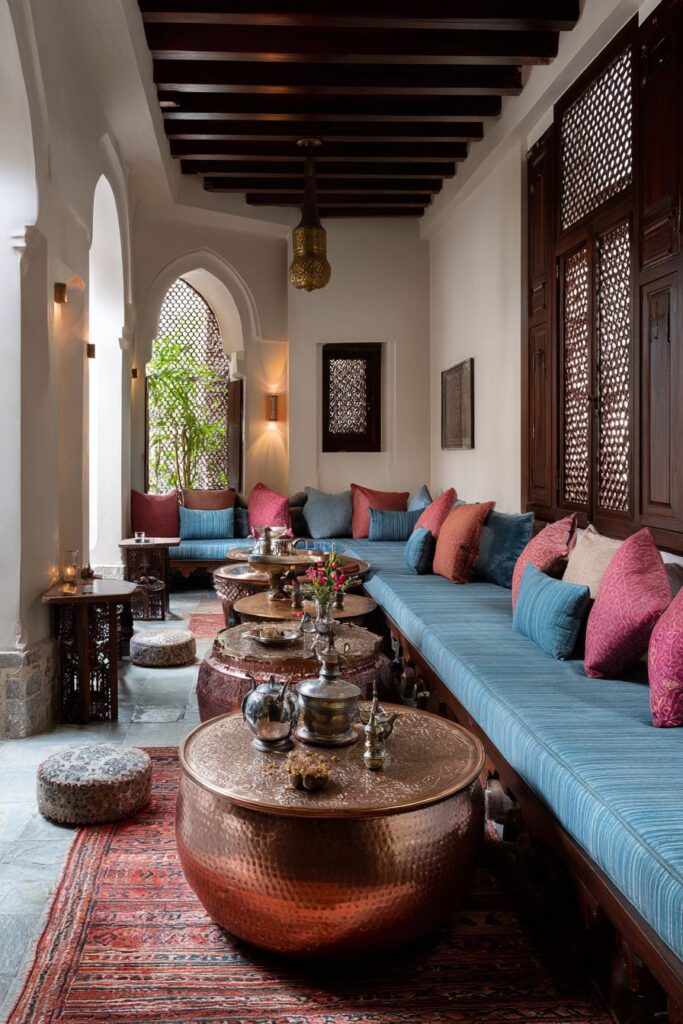
Enter a living room transformed by the breathtaking presence of a mashrabiya wooden screen that serves as both functional room divider and artistic masterpiece. This stunning example of traditional Islamic woodwork showcases intricate geometric latticework that filters natural light into mesmerizing shadow patterns, creating an ever-changing display of light and shadow that transforms throughout the day. The screen’s complex geometric patterns reflect the mathematical precision and artistic sophistication that characterizes the finest examples of Islamic decorative arts.

Surrounding this magnificent centerpiece, plush floor cushions in jewel tones create intimate seating arrangements that honor traditional Middle Eastern hospitality customs. These carefully selected cushions in sapphire blues, emerald greens, and ruby reds create a rich tapestry of color that complements the natural wood tones of the mashrabiya screen. The low seating arrangement encourages relaxation and informal conversation, embodying the Arabic tradition of comfortable, communal gathering spaces.
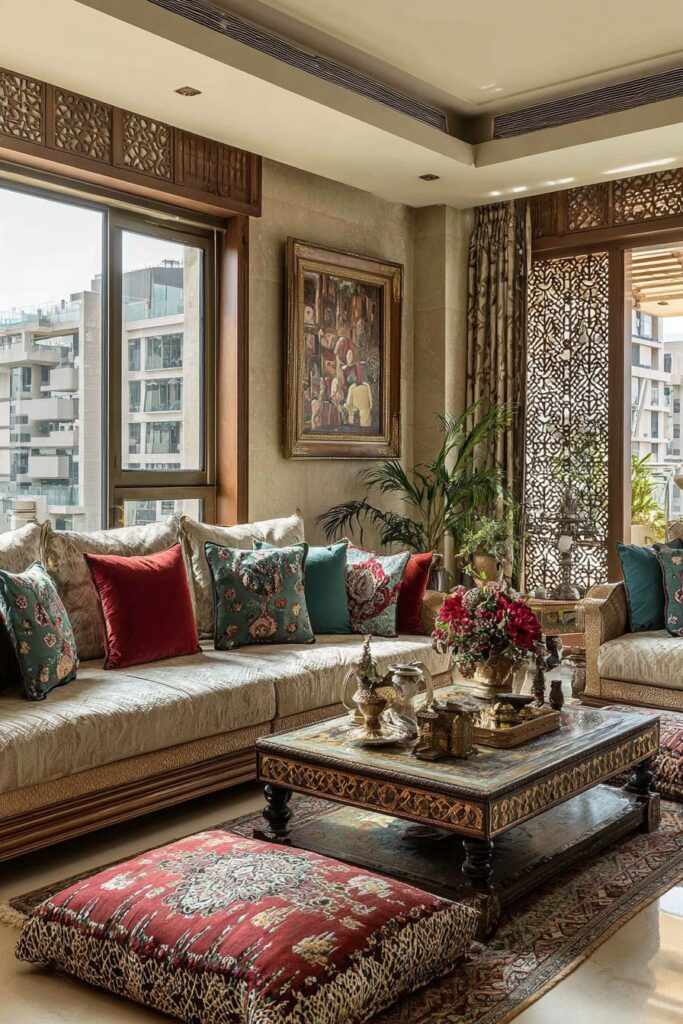
The centerpiece of the seating arrangement features a low copper coffee table with detailed engravings that showcase traditional Arabic metalwork techniques. This functional art piece serves dual purposes as both practical surface and decorative element, its aged patina and intricate details adding authenticity and character to the space. The engravings tell stories through their patterns, connecting the present moment to generations of skilled craftsmen who perfected these techniques.
Traditional kilim rugs in earthy tones layer across the floor space, creating zones of comfort while adding textural variety and cultural authenticity. These flat-woven masterpieces bring additional geometric patterns into the space while providing practical benefits of warmth and sound absorption. The layering of multiple rugs creates visual depth and helps define different areas within the larger room.

Key Design Tips:
- Install mashrabiya screens near windows to maximize the dramatic light filtering effects throughout the day
- Choose floor cushions in jewel tones that complement the natural wood finish of traditional screens
- Layer multiple kilim rugs to create defined seating areas and add textural variety to the floor
- Select copper or brass coffee tables with traditional engravings to maintain authentic metalwork themes
- Position seating to take advantage of the beautiful shadow patterns created by geometric latticework
3. Luxurious Mother-of-Pearl Inlay Paradise
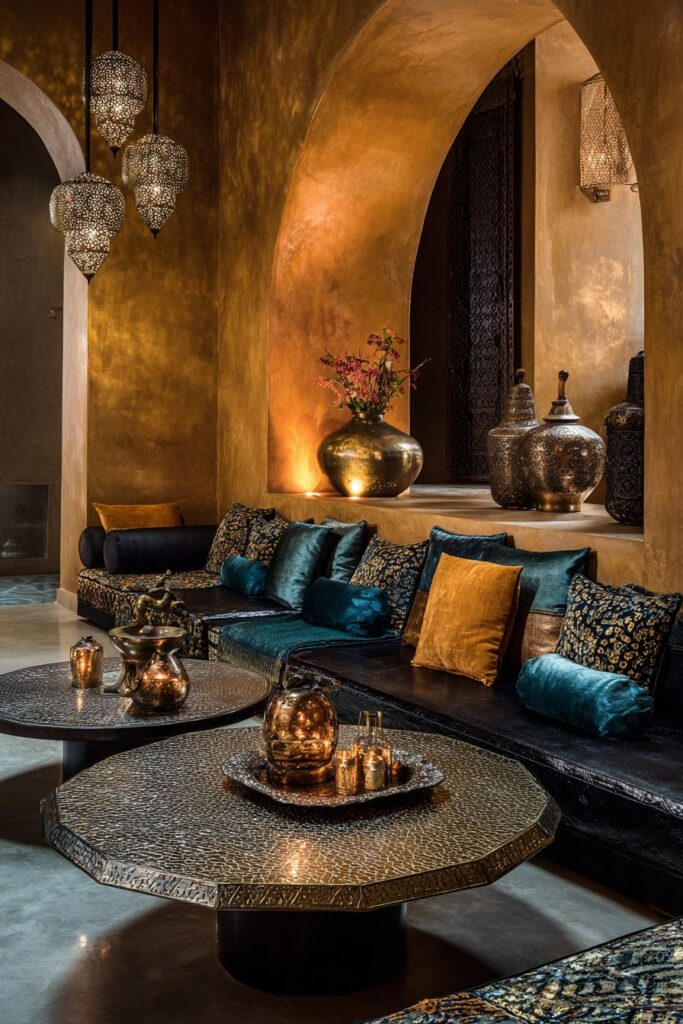
Immerse yourself in a living room that epitomizes Arabic luxury through its centerpiece: an ornate mother-of-pearl inlaid coffee table that serves as both functional furniture and artistic masterpiece. This extraordinary piece showcases the ancient art of mother-of-pearl inlay work, where countless tiny pieces of lustrous shell create intricate geometric and floral patterns that shimmer and change as light moves across their surfaces. The table represents hundreds of hours of skilled craftmanship, connecting modern living spaces to centuries-old traditions of decorative arts.
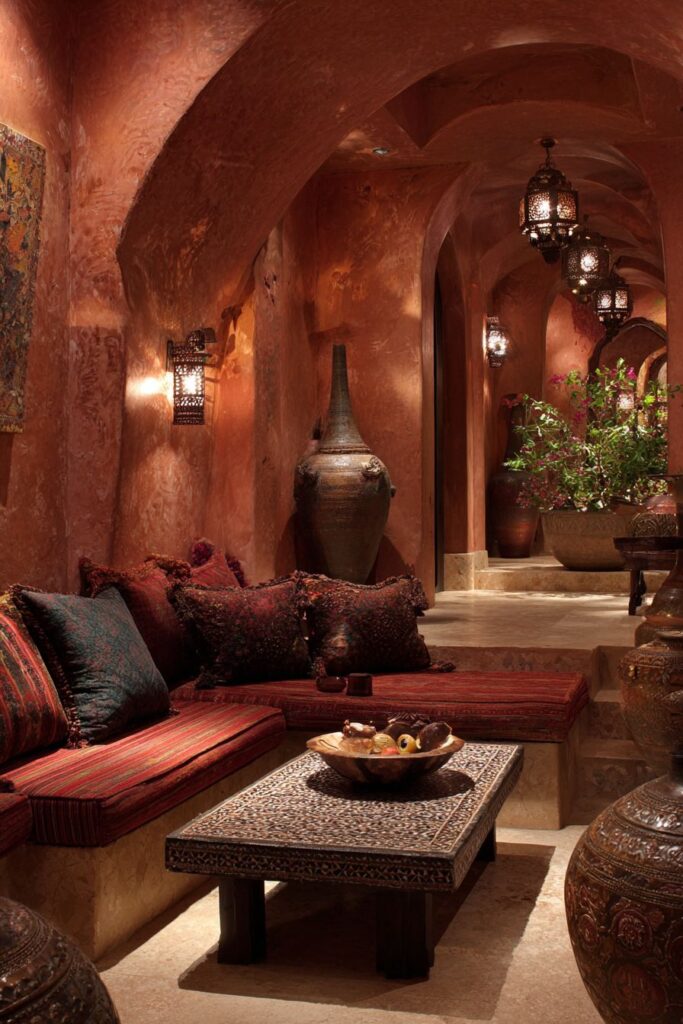
Surrounding this magnificent focal point, low seating arrangements feature sumptuous velvet cushions in deep emerald and sapphire hues that echo the precious gemstone traditions of Arabic design. The velvet’s rich texture provides both visual and tactile luxury, inviting touch while creating deep, saturated colors that serve as perfect foils to the iridescent mother-of-pearl inlays. Each cushion has been carefully positioned to create conversation groupings while maintaining clear sight lines to the stunning coffee table.
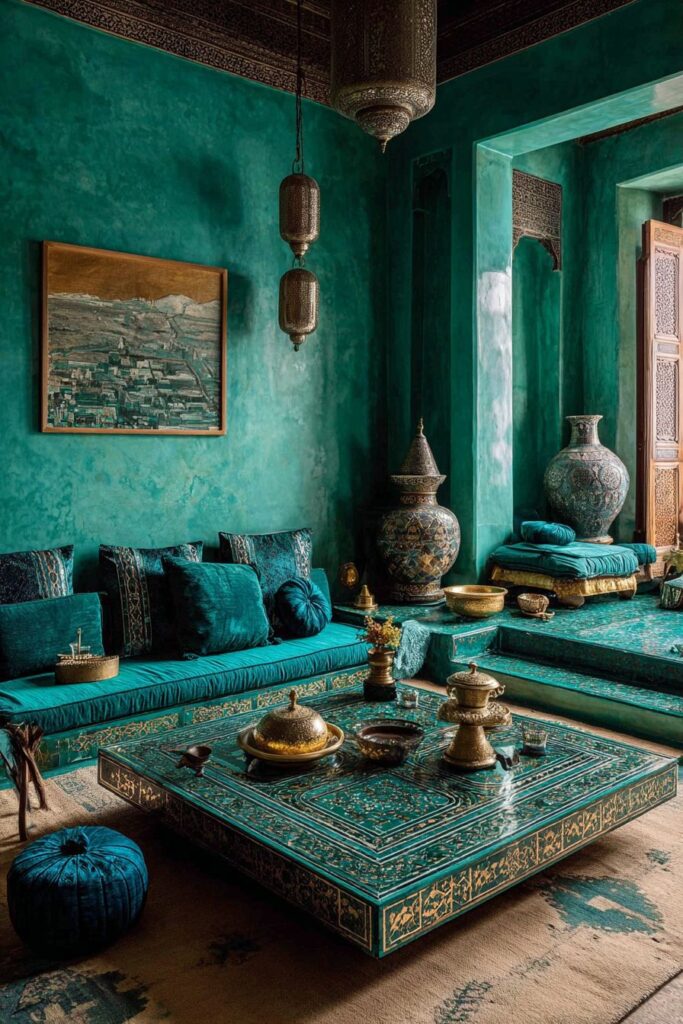
The walls feature traditional tadelakt plaster in warm terra cotta tones, applied with subtle texture variations that create visual interest without overwhelming the space. This ancient Moroccan plastering technique produces a subtle sheen and organic texture that adds warmth and authenticity to the room. The terra cotta coloring provides a neutral backdrop that allows the jewel-toned furnishings and metallic accents to take center stage.
Throughout the space, antique brass accessories and ceramic vessels create curated displays that add layers of cultural significance and visual interest. These carefully selected pieces include traditional coffee pots, serving vessels, and decorative objects that tell stories of Arabic hospitality traditions. The brass develops beautiful patina over time, adding to the authentic atmosphere of the space.

Key Design Tips:
- Invest in authentic mother-of-pearl inlay furniture as statement pieces that provide both function and artistic value
- Choose velvet cushions in deep jewel tones to create luxurious seating that complements metallic accents
- Apply tadelakt plaster in warm earth tones to create textured wall surfaces that add authenticity
- Display antique brass accessories in odd-numbered groupings for visual appeal and cultural significance
- Use soft, diffused lighting to highlight the iridescent qualities of mother-of-pearl inlay work
4. Medallion Carpet Magnificence

Enter a living room where a magnificent hand-knotted carpet with intricate medallion patterns commands attention as the undisputed focal point of the design. This masterpiece of textile art displays deep reds and navy blues woven into complex geometric medallions that represent the highest achievement in Persian and Arabic rug-making traditions. Each knot tells a story, with the carpet requiring months or even years to complete, making it not just a floor covering but a treasured heirloom that connects past and present.

Built-in banquette seating with ornate carved wooden backs lines the walls, creating a formal yet comfortable seating arrangement that maximizes the room’s capacity while maintaining elegant proportions. The wooden carvings showcase traditional Arabic woodworking techniques, featuring geometric patterns and flowing curves that complement the carpet’s designs. Topped with silk cushions in complementary colors, these seating areas provide luxurious comfort while maintaining the visual coherence of the overall design scheme.

Decorative ceramic tiles with geometric Islamic patterns accent the lower walls, creating a wainscoting effect that adds visual weight to the room’s base while protecting walls from daily wear. These tiles, often hand-painted or hand-cut, display the mathematical precision and artistic beauty characteristic of Islamic decorative arts. The geometric patterns in the tiles echo and amplify the motifs found in the central carpet, creating visual harmony throughout the space.
Natural daylight streams through arched windows fitted with traditional wooden shutters, creating beautiful light patterns that change throughout the day. The arched window shapes reflect traditional Islamic architecture while the wooden shutters provide both practical light control and additional authentic detailing. This natural light illuminates the rich colors of the textiles and highlights the intricate patterns in both carpet and tile work.
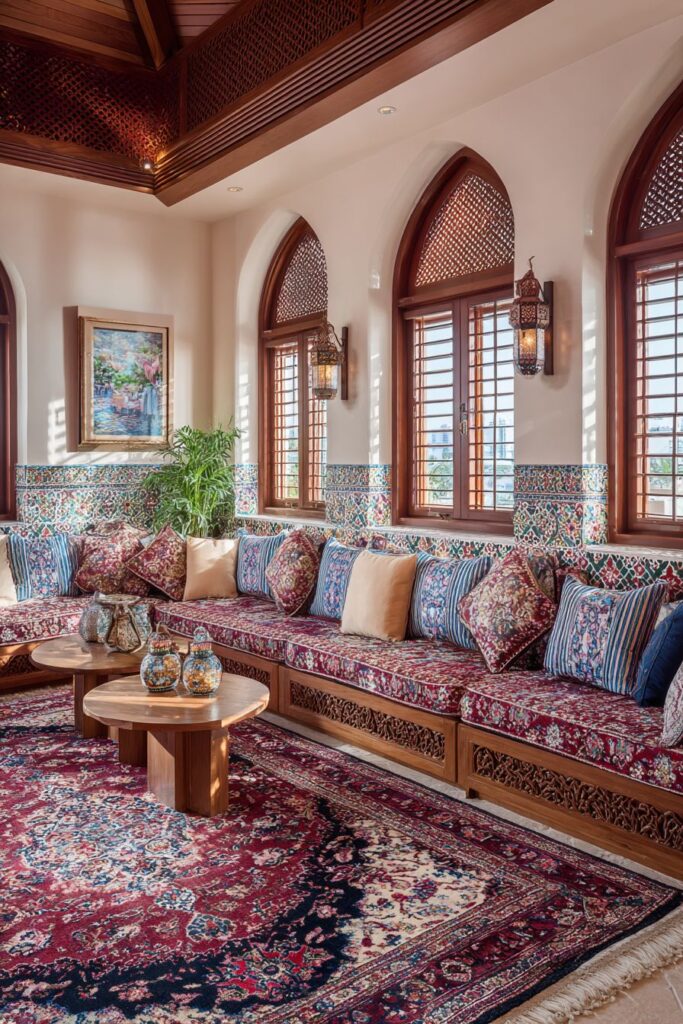
Key Design Tips:
- Select hand-knotted carpets with medallion patterns as central design elements that unify the entire room
- Install built-in banquette seating to maximize seating capacity while maintaining clean architectural lines
- Use decorative ceramic tiles as wainscoting to add pattern and protect walls in high-traffic areas
- Choose silk cushions in colors that complement rather than compete with the main carpet’s palette
- Install arched windows with wooden shutters to control natural light while maintaining architectural authenticity
5. Contemporary Arabic Fusion Excellence

Discover a living room that successfully bridges traditional Arabic design elements with contemporary comfort, creating a space that honors cultural heritage while meeting modern lifestyle needs. The centerpiece sectional sofa in neutral linen provides generous seating for today’s family gatherings while serving as a perfect canvas for colorful throw pillows that display traditional Arabic patterns. This approach allows for easy updating of colors and patterns while maintaining the substantial comfort that contemporary living demands.
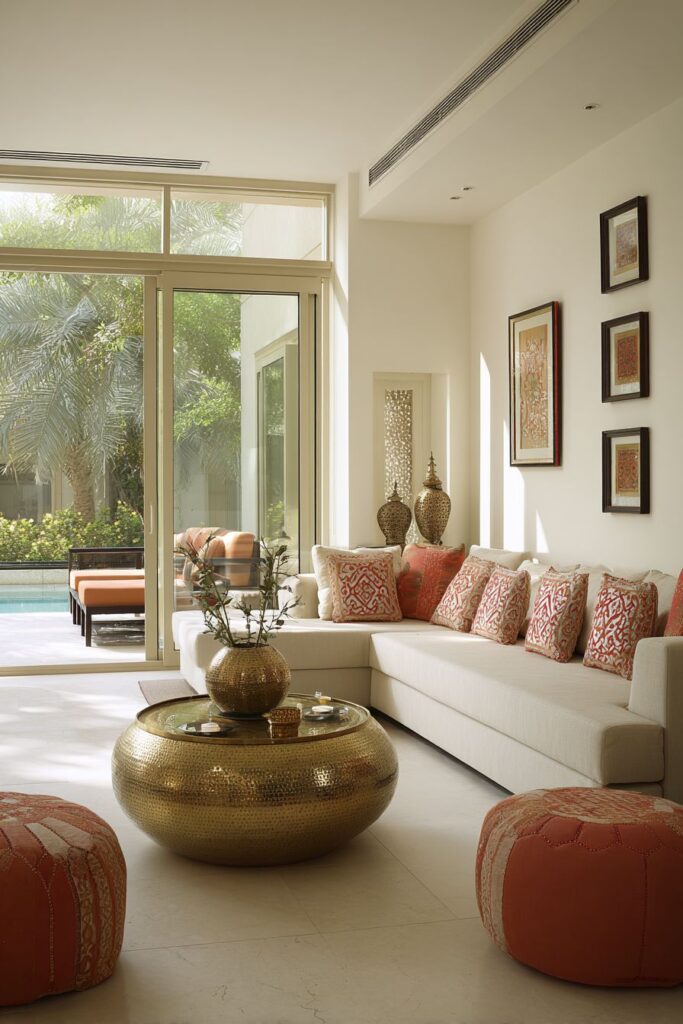
The genius of this design lies in its thoughtful integration of authentic elements with modern functionality. A large vintage brass tray serves as an innovative coffee table centerpiece, transforming a traditional serving piece into contemporary furniture. This repurposing of traditional objects demonstrates how Arabic design principles can adapt to modern living while maintaining their cultural significance and visual impact.

Surrounding the main seating area, poufs upholstered in supple Moroccan leather provide additional flexible seating that can be easily moved to accommodate different activities and group sizes. These traditional seating elements add authenticity while offering practical benefits of portability and space efficiency. The leather develops character over time, improving with age and use in the tradition of quality craftsmanship.
The walls showcase a carefully curated collection of traditional Arabic metalwork and ceramics, creating gallery-like displays that serve as both decoration and cultural education. These authentic pieces, ranging from antique serving vessels to decorative plates and calligraphy, tell stories of Arabic artistic traditions while adding visual interest and cultural depth to the contemporary setting.
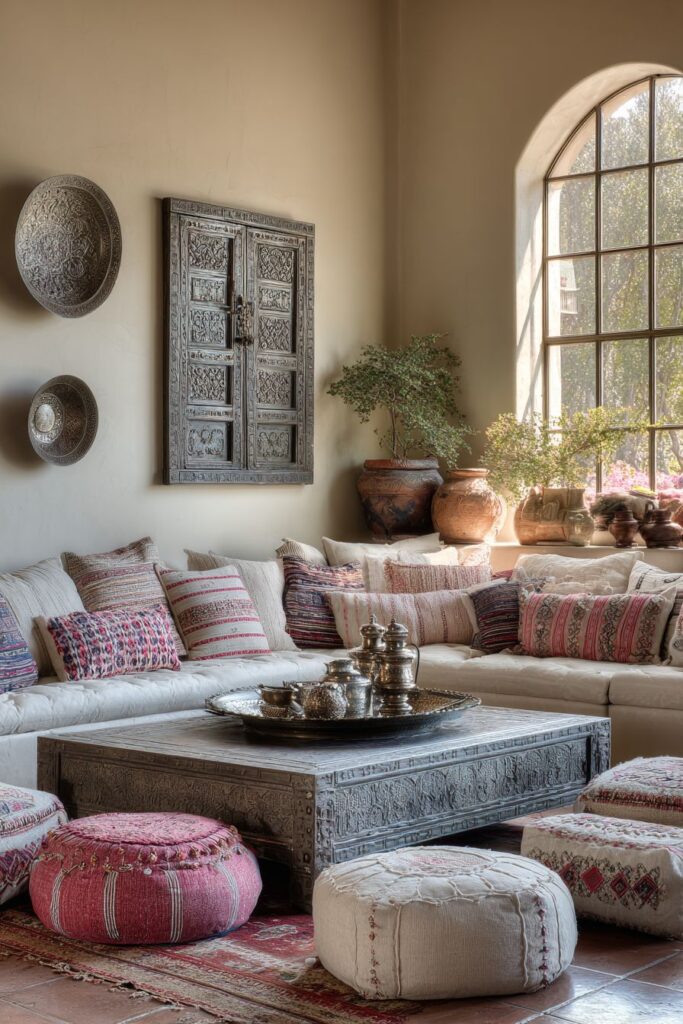
Key Design Tips:
- Choose neutral sectional sofas as base furniture that can be updated with traditional patterned accessories
- Repurpose large vintage trays as coffee tables to blend traditional elements with modern functionality
- Add Moroccan leather poufs for flexible seating that maintains authentic Arabic design elements
- Create gallery walls with traditional metalwork and ceramics to add cultural significance
- Balance contemporary comfort with traditional accessories for successful fusion design
6. Architectural Grandeur with Horseshoe Arches
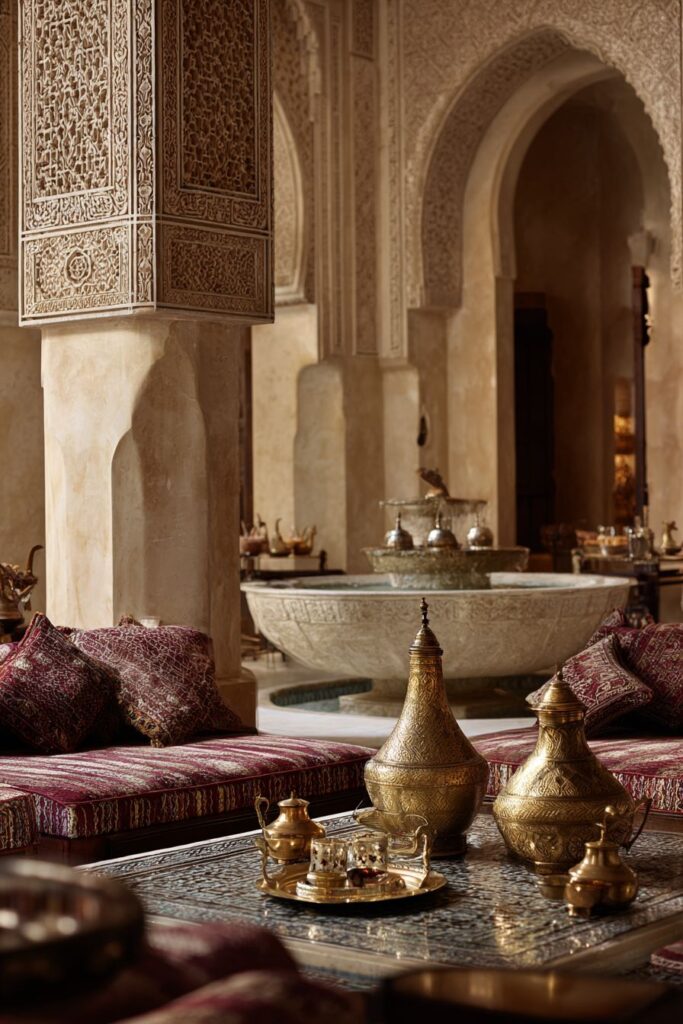
Step into a living room that showcases the magnificent architectural heritage of Arabic design through traditional horseshoe arches and decorative plasterwork featuring intricate muqarnas details. These architectural elements transform an ordinary room into a space of extraordinary beauty, where every curve and decorative detail reflects centuries of refined building traditions. The horseshoe arches create dramatic sight lines and frame views throughout the space, while their curved forms soften the overall architectural impact.

The muqarnas details represent one of the most sophisticated achievements in Islamic decorative arts, featuring three-dimensional honeycomb-like structures that create complex plays of light and shadow. These sculptural elements add incredible visual richness to ceiling and wall surfaces, demonstrating the mathematical precision and artistic vision that characterizes the finest Arabic architecture. Each individual cell catches and reflects light differently, creating an ever-changing display of highlights and shadows.
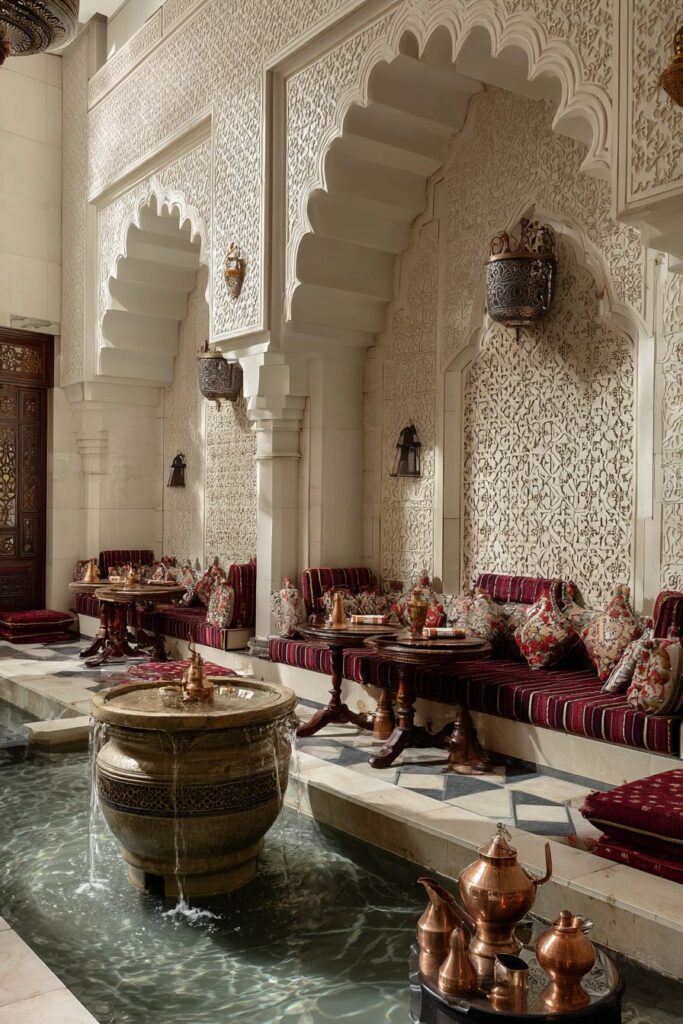
Low divans with rich fabric upholstery in burgundy and gold line the walls beneath these architectural marvels, creating formal seating arrangements that complement the grandeur of the space. The fabrics chosen for these divans feature traditional patterns and luxurious textures that can withstand the visual weight of the elaborate architectural details. Accompanied by an array of patterned cushions, these seating areas provide comfort while maintaining visual coherence with the ornate surroundings.
A central fountain feature adds the tranquil sound of moving water while serving as both functional and decorative element. This water feature connects to ancient traditions of Arabic garden design, where water provided both cooling and aesthetic benefits. Traditional brass and copper vessels arranged around the fountain serve as decorative accents while reinforcing the cultural authenticity of the design approach.

Key Design Tips:
- Install horseshoe arches to create dramatic architectural focal points that frame different areas
- Incorporate muqarnas plasterwork for ceiling details that add three-dimensional visual interest
- Choose rich fabric upholstery that can compete visually with elaborate architectural details
- Add water features to provide soothing sounds and connect to traditional Arabic design principles
- Display traditional brass and copper vessels to reinforce authentic cultural themes
7. Layered Persian and Arabian Rug Symphony
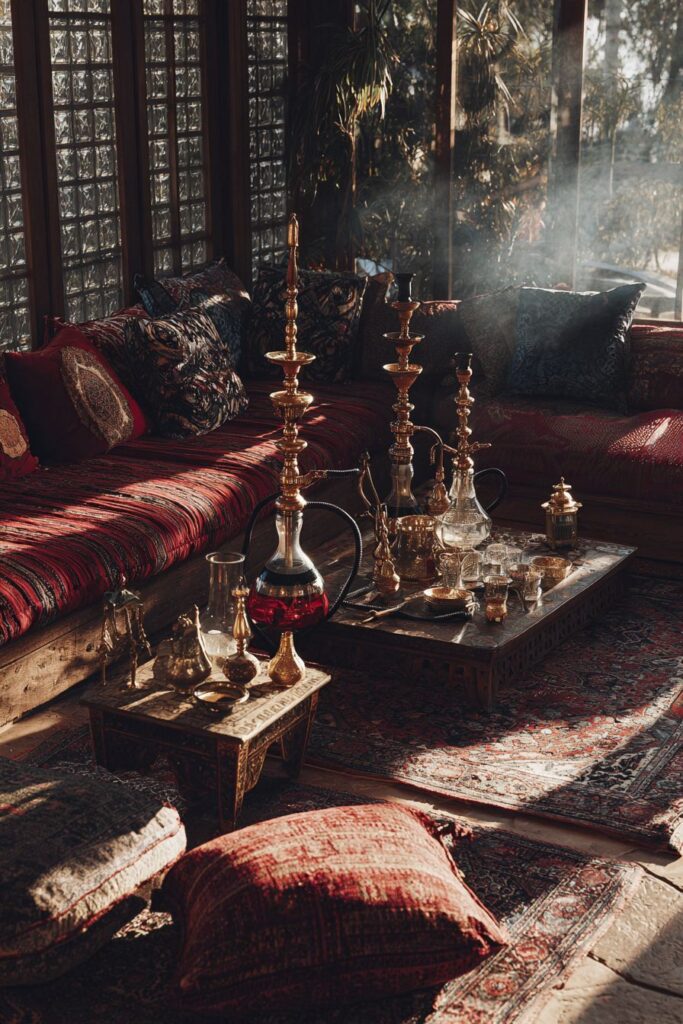
Enter a living room that celebrates the art of rug layering through an impressive collection of antique Persian and Arabian carpets arranged in harmonious patterns and colors across the floor. This sophisticated approach to floor covering creates incredible visual depth while showcasing the individual beauty of each piece. The layering technique allows for the display of multiple masterpiece textiles while creating zones of different colors and patterns that define various seating and activity areas within the larger space.
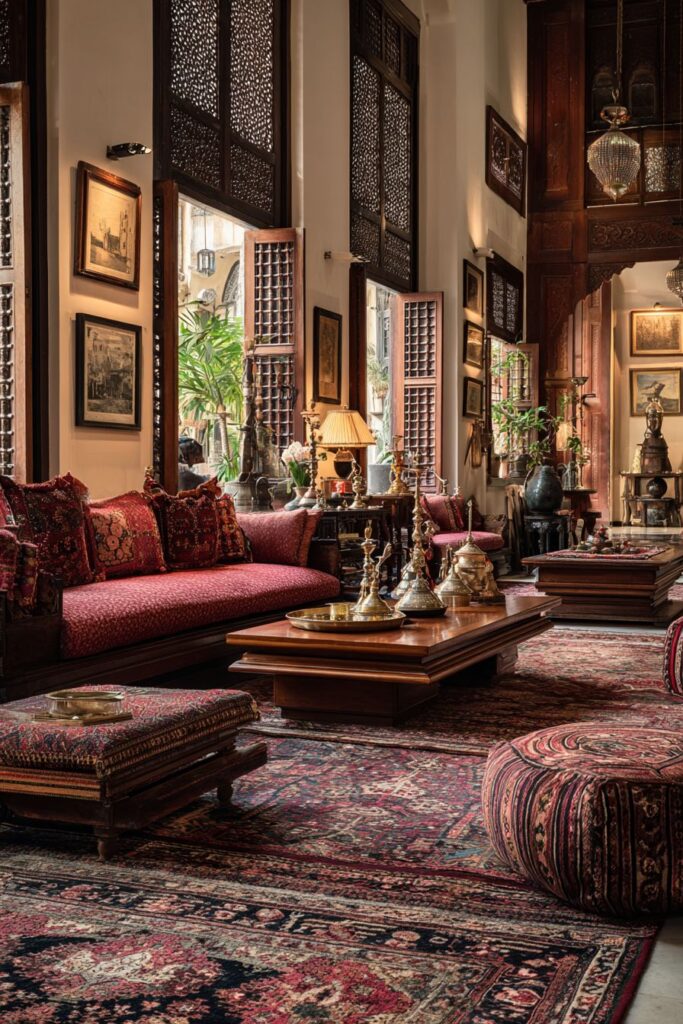
Each rug in this collection represents months or years of skilled handwork, with patterns that tell stories of regional traditions and artistic heritage. The careful selection and placement of these textiles creates a floor covering that functions as art installation, where visitors can appreciate both individual pieces and their collective impact. The overlapping edges and varying sizes create organic boundaries between different areas while maintaining visual flow throughout the space.
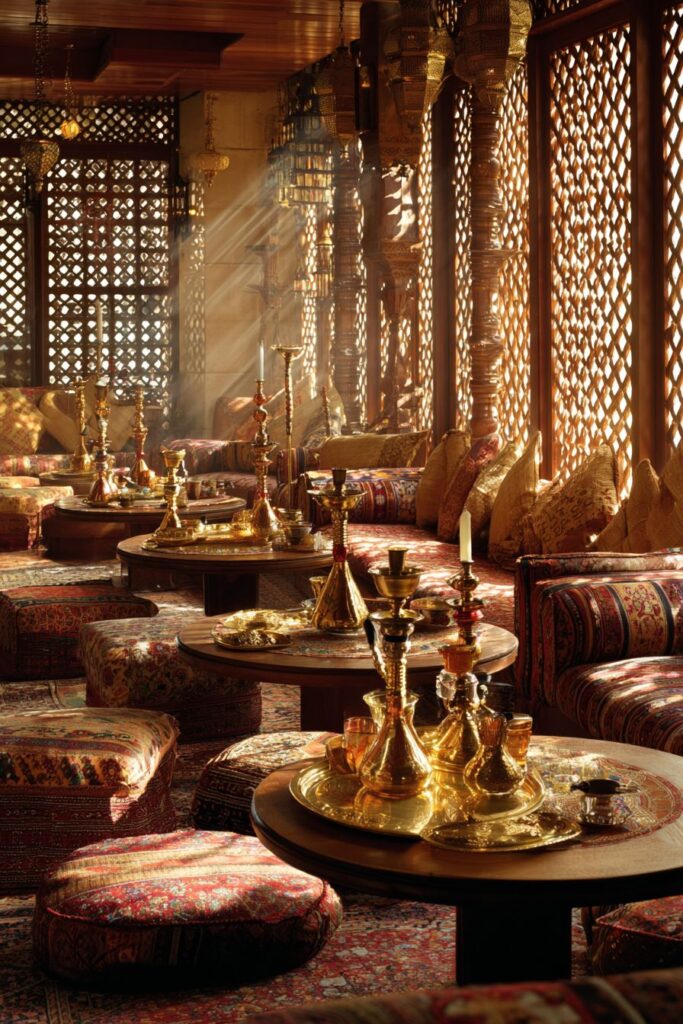
Traditional low seating with carved wooden frames and silk brocade upholstery creates an authentic majlis arrangement that honors Middle Eastern hospitality traditions. The wooden frames showcase intricate carving details that complement the geometric patterns found in the rugs below, while the silk brocade provides luxurious comfort in colors carefully selected to harmonize with the textile collection. This seating arrangement encourages intimate conversation while providing clear views of the spectacular floor covering.
Ornate hookahs and brass tea services displayed on low tables throughout the space add functional authenticity while creating opportunities for traditional Arabic hospitality rituals. These pieces, carefully selected for both beauty and historical accuracy, connect modern living to centuries-old traditions of gracious entertaining and social gathering.
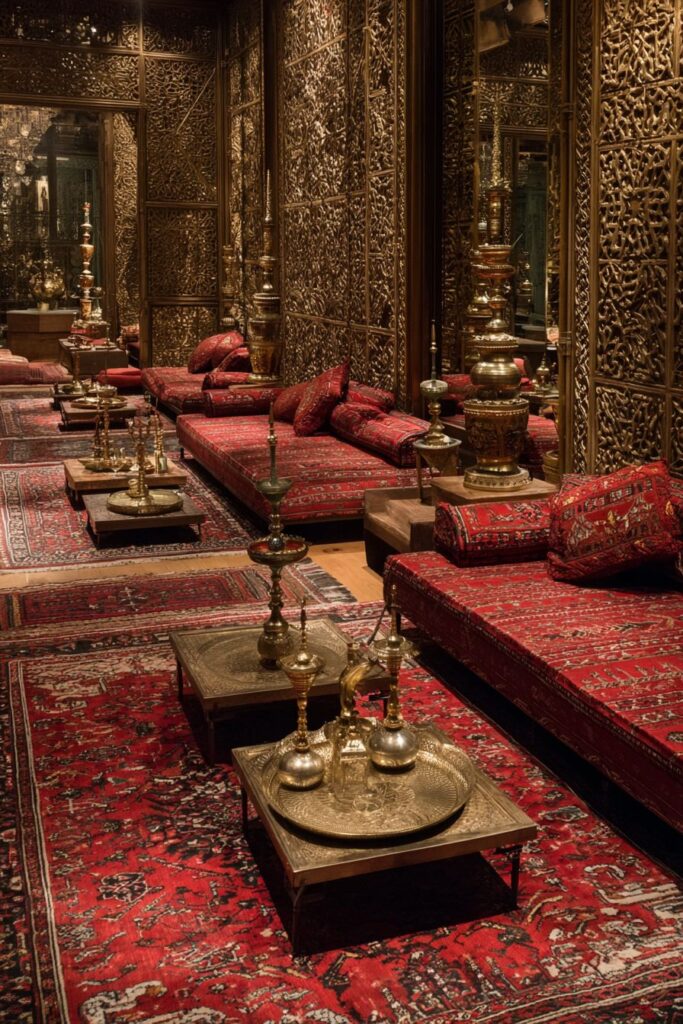
Key Design Tips:
- Layer multiple rugs of different sizes and complementary patterns to create visual zones and depth
- Select antique or high-quality reproduction rugs that represent different regional traditions
- Choose low seating with carved wooden frames that complement the geometric patterns in textile displays
- Display traditional serving pieces like hookahs and tea services as functional decorative elements
- Position layered rugs to define different activity areas while maintaining overall visual flow
8. Geometric Tile Feature Wall Masterpiece
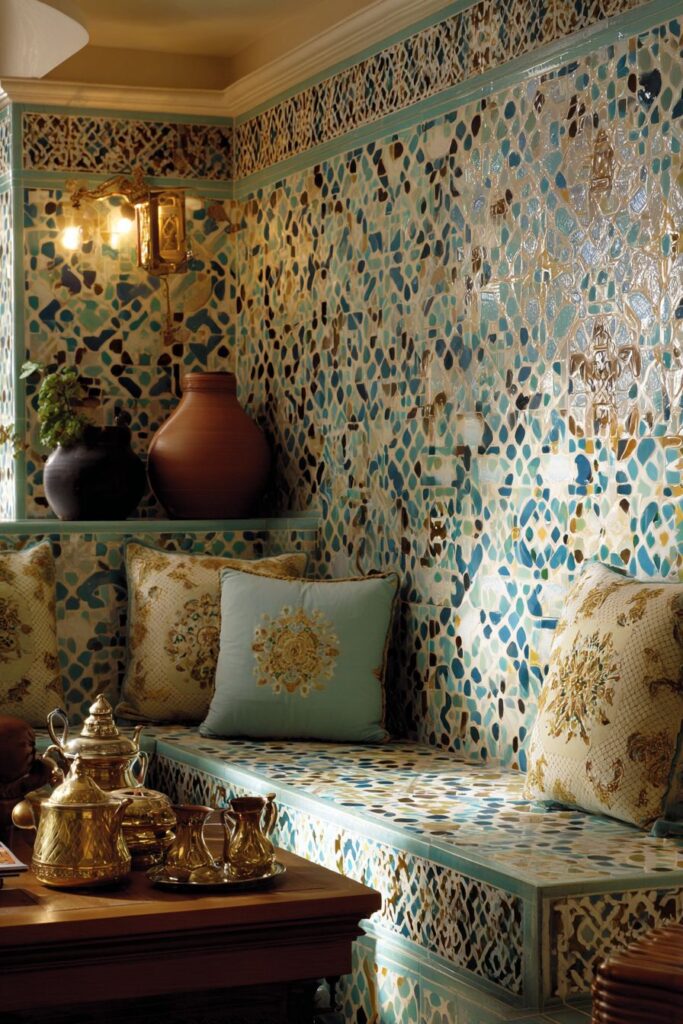
Immerse yourself in a living room dominated by a stunning ceramic tile feature wall that displays traditional Islamic geometric patterns in blues, greens, and gold. This architectural masterpiece serves as both art installation and cultural expression, where mathematical precision meets artistic vision to create patterns of incredible complexity and beauty. Each tile represents skilled craftsmanship, with hand-painted or hand-cut details that reflect centuries of ceramic arts traditions in the Islamic world.

The geometric patterns displayed on this feature wall follow ancient mathematical principles that create infinite repeating designs, symbolizing the eternal nature of divine creation in Islamic philosophy. The blues, greens, and gold create a sophisticated color palette that serves as the foundation for all other design decisions in the room. These colors not only provide visual beauty but also carry cultural significance, with blue representing infinity, green symbolizing paradise, and gold representing divine light.
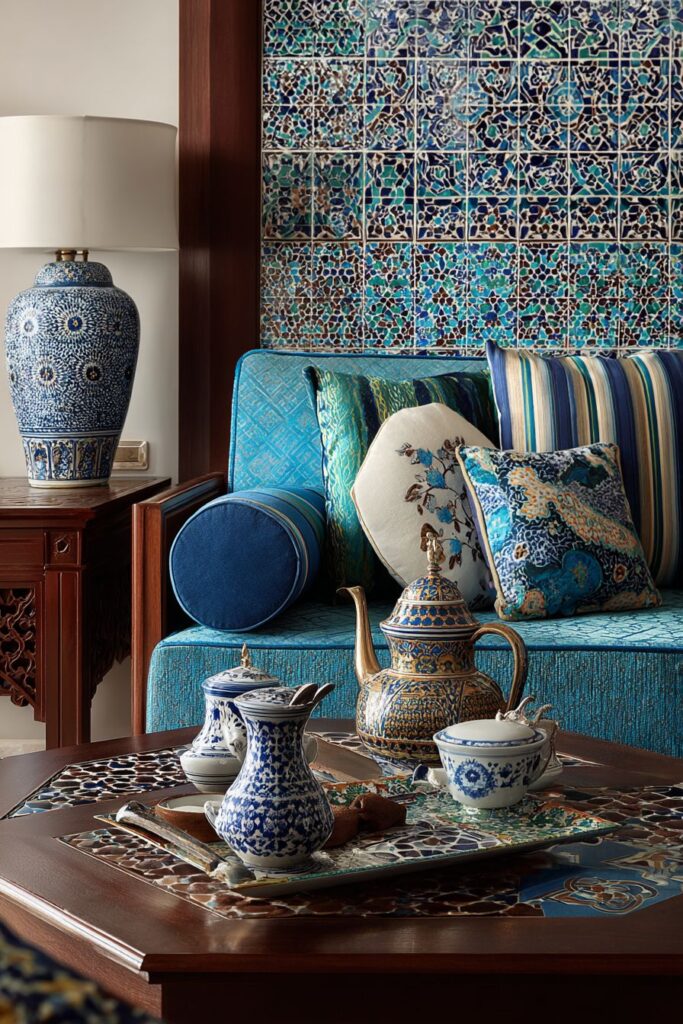
Comfortable floor seating with embroidered cushions in coordinating colors creates an intimate conversation area positioned to take full advantage of the tile wall’s visual impact. The embroidered cushions feature patterns that complement rather than compete with the geometric tile work, creating visual harmony through thoughtful color and pattern coordination. This low seating arrangement maintains traditional Arabic hospitality customs while providing contemporary comfort.
Traditional Arabic coffee pots and serving vessels arranged on a low carved wooden table complete the cultural authenticity of the space while providing practical function for traditional hospitality rituals. These metalwork pieces, carefully selected for their historical accuracy and artistic merit, add three-dimensional interest while reinforcing the cultural themes established by the tile work.
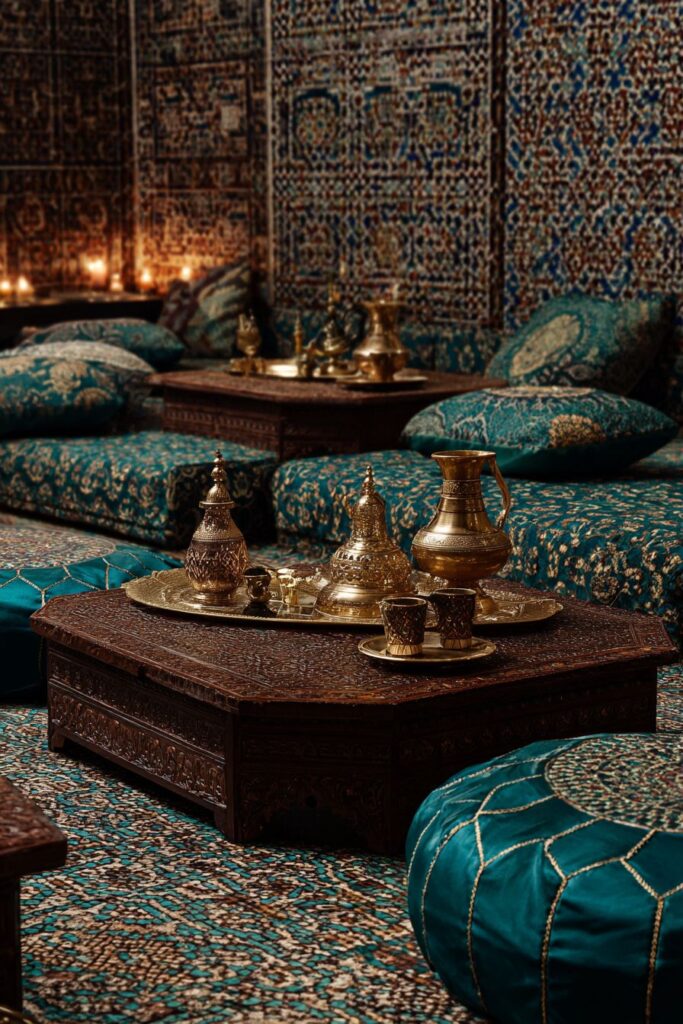
Key Design Tips:
- Create feature walls with traditional Islamic geometric tiles to establish strong visual focal points
- Choose tile colors that can serve as the foundation palette for all other room elements
- Position seating to maximize views and appreciation of intricate tile work and patterns
- Select embroidered cushions with patterns that complement rather than compete with tile designs
- Display traditional metalwork serving pieces to reinforce cultural authenticity and provide function
9. Tent-Inspired Romantic Drapery
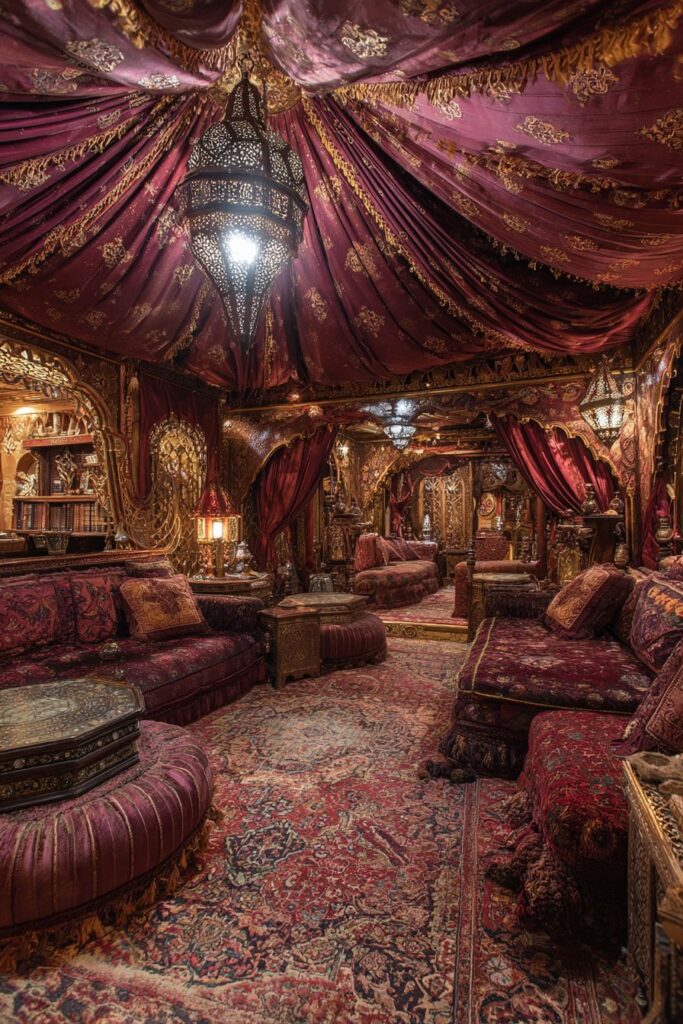
Enter a living room transformed by traditional tent-inspired drapery that creates intimate seating nooks reminiscent of luxury Bedouin encampments. Rich fabrics in deep jewel tones cascade from ceiling to floor, creating enclosed spaces that provide privacy and intimacy within the larger room. This dramatic treatment transforms ordinary architecture into something magical and exotic, where fabric becomes architecture and creates completely different spatial experiences.

The tent-like drapery serves multiple purposes beyond mere decoration, providing acoustic softening, light control, and climate modification while creating psychological comfort through enclosure. The deep jewel tones chosen for these fabrics—sapphire blues, emerald greens, and ruby reds—create richly saturated environments that feel luxurious and cocoon-like. The weight and texture of these fabrics add substantial visual and tactile richness to the space.
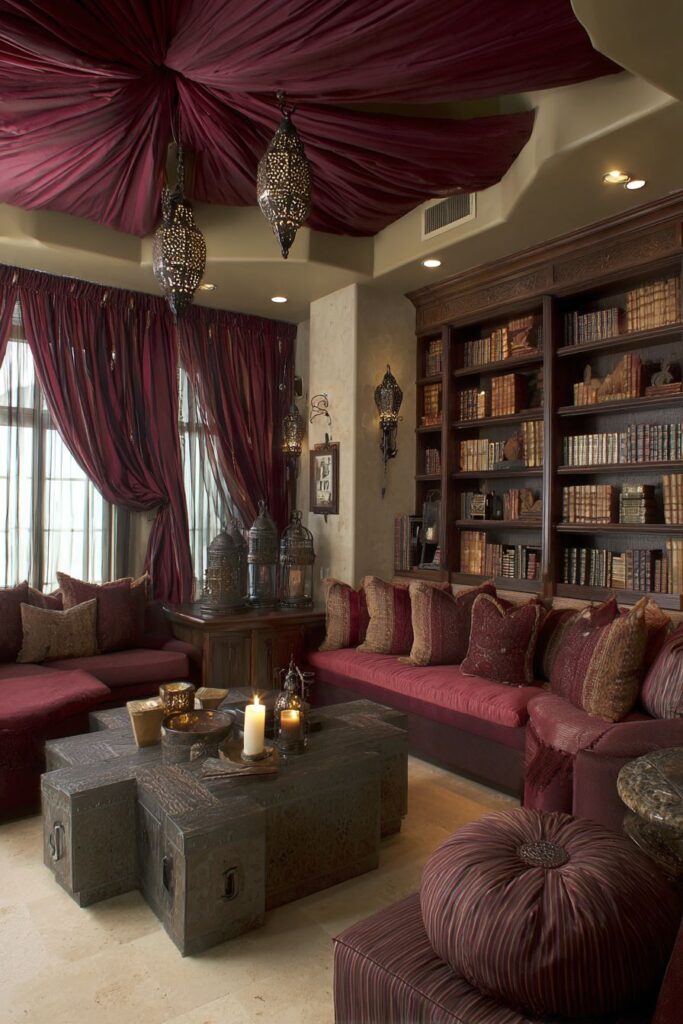
Ornate metal lanterns with pierced patterns suspended at varying heights cast intricate light designs across walls and ceiling surfaces, creating ever-changing patterns that shift throughout the day as natural light levels change. These lanterns represent traditional Middle Eastern lighting design, where functional illumination becomes decorative art through careful attention to pattern and placement. The pierced metal work creates hundreds of tiny light points that sparkle like stars against the rich fabric backgrounds.
A carefully curated collection of vintage Arabic manuscripts and books displayed on built-in shelving with decorative brackets adds intellectual and cultural depth to the romantic atmosphere. These authentic texts, whether original manuscripts or high-quality reproductions, connect the space to the rich literary and scholarly traditions of Arabic culture while providing visual interest through their varied sizes, bindings, and calligraphic elements.
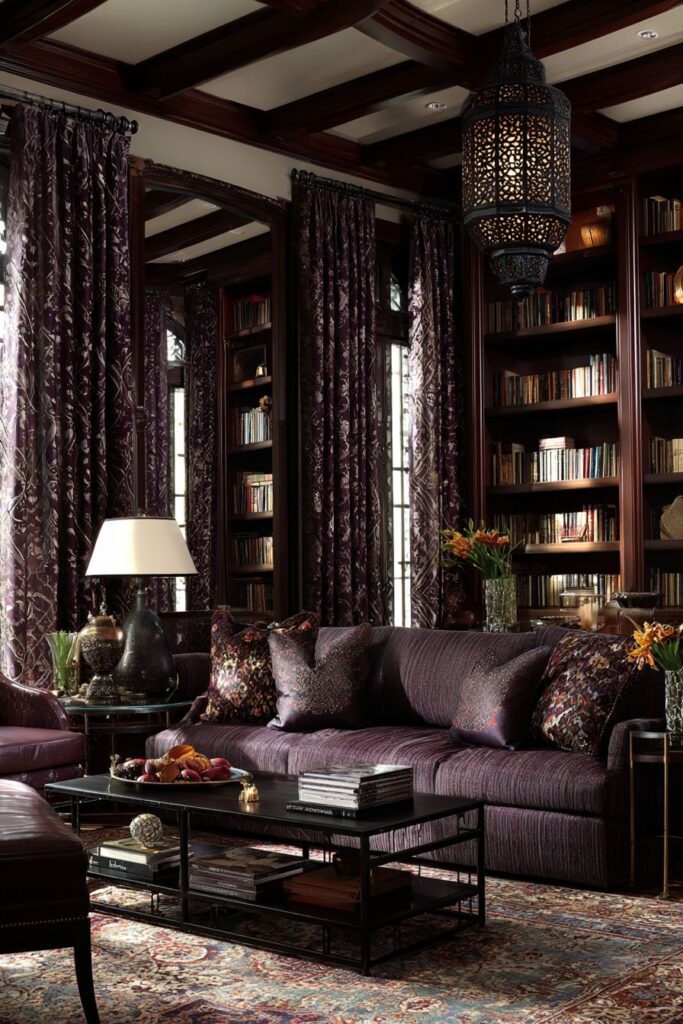
Key Design Tips:
- Use ceiling-mounted drapery in rich fabrics to create intimate tent-like seating areas
- Choose deep jewel tones for fabrics that create luxurious, cocoon-like environments
- Install pierced metal lanterns at varying heights to create dramatic lighting effects
- Display Arabic manuscripts and books to add cultural depth and intellectual interest
- Position fabric panels to create natural traffic flow while maintaining intimate spaces
10. Hand-Painted Wooden Ceiling Grandeur
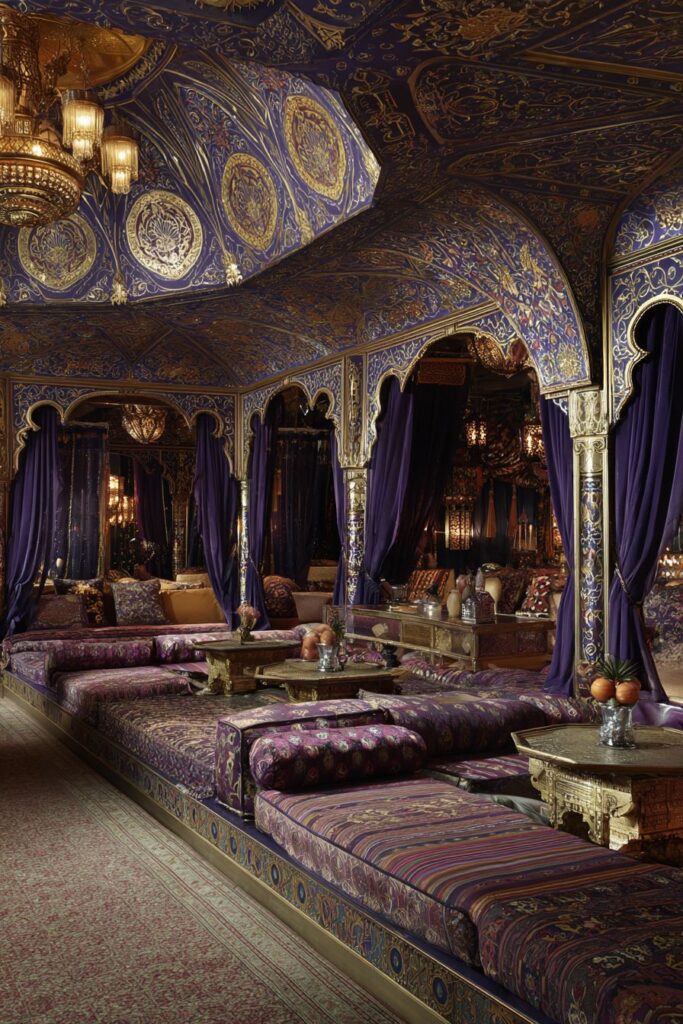
Marvel at a living room crowned by a magnificent hand-painted wooden ceiling featuring traditional geometric and floral motifs rendered in gold and deep blue. This extraordinary architectural element represents the highest achievement in Arabic decorative arts, where skilled artisans transform structural elements into canvases for artistic expression. The intricate patterns follow mathematical principles while incorporating organic floral elements, creating a perfect balance between geometric precision and natural beauty that draws the eye upward in wonder.
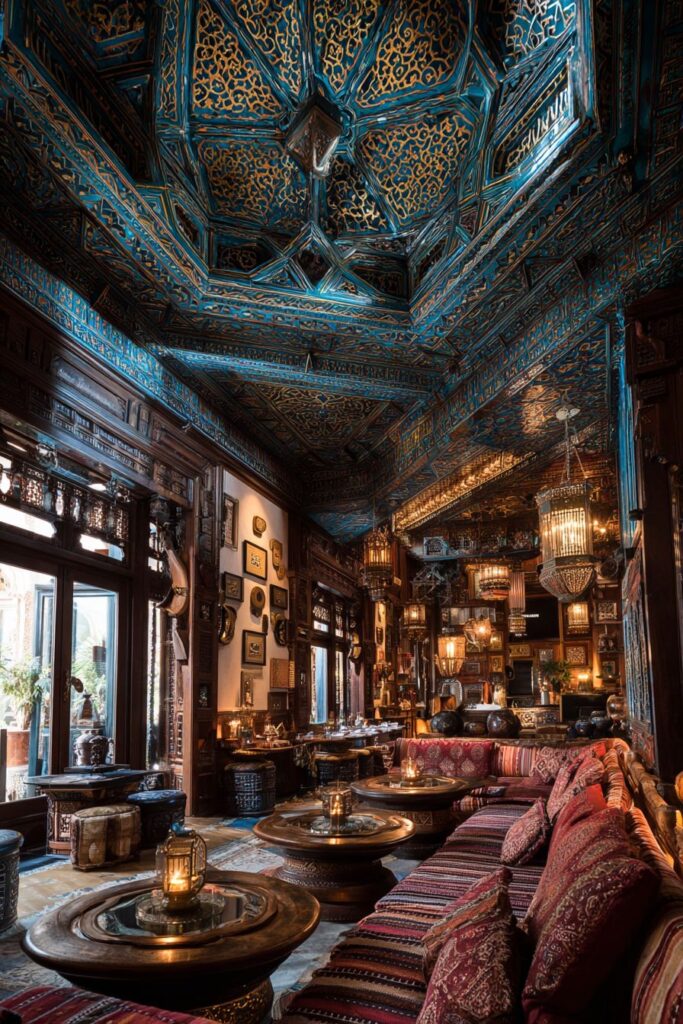
The gold and deep blue color scheme chosen for the ceiling creates a sense of infinite sky, with the metallic gold catching and reflecting light throughout the day to create an ever-changing display of highlights and shadows. This traditional color combination represents divine light against the deep blue of infinite space, connecting earthly gathering spaces to cosmic themes that inspire contemplation and conversation.
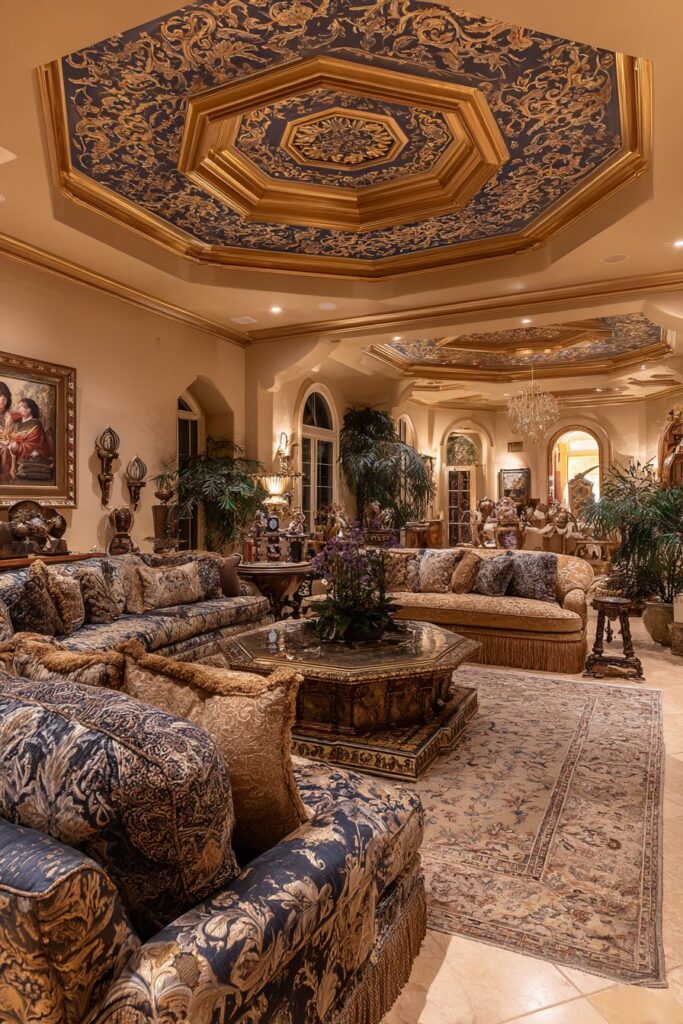
Below this celestial canopy, low platform seating with rich tapestry upholstery surrounds a central area featuring a decorative water feature that provides both visual focus and soothing sounds. The platform seating creates clean architectural lines that complement rather than compete with the ornate ceiling treatment, while the rich tapestry upholstery adds pattern and texture at human scale. The central water feature connects to ancient Arabic traditions where water represented both practical cooling and spiritual purification.
Traditional Arabic musical instruments displayed as wall art alongside vintage photographs create cultural vignettes that add personal and historical interest to the space. These carefully curated displays include instruments like ouds, drums, and flutes that represent the rich musical heritage of Arabic culture, while vintage photographs provide glimpses into historical contexts and family memories.
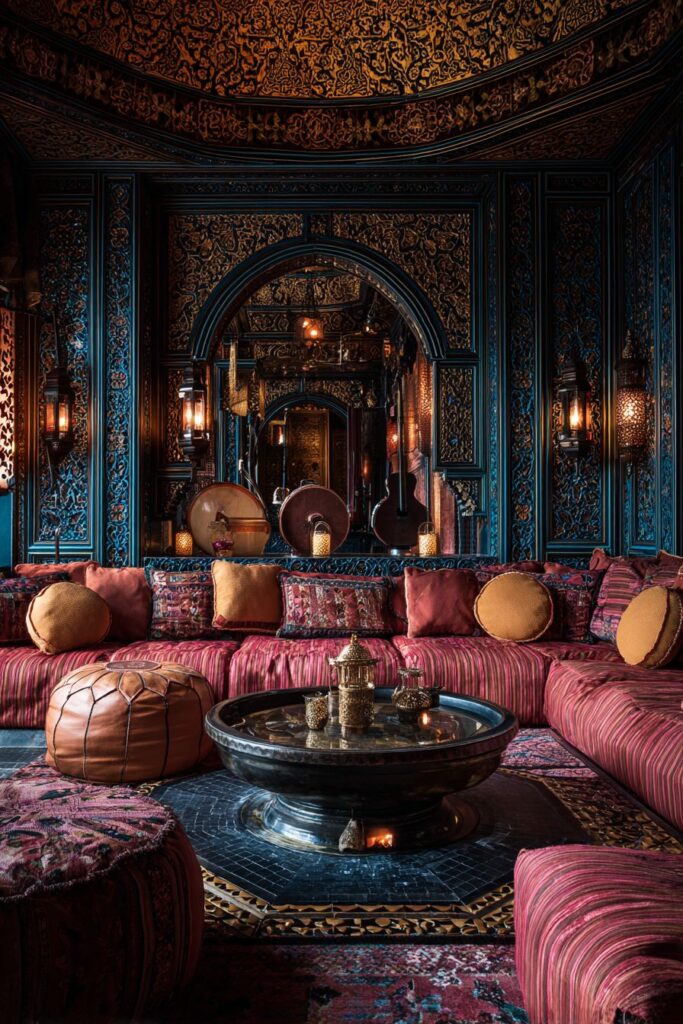
Key Design Tips:
- Commission hand-painted ceiling treatments with traditional motifs to create spectacular overhead focal points
- Use gold and blue color schemes that provide both beauty and cultural significance
- Install platform seating with clean lines that complement rather than compete with ornate ceiling details
- Add central water features to provide focal points and soothing background sounds
- Display musical instruments and photographs as cultural artifacts that add personal meaning
11. Antique Wooden Chest Centerpiece

Discover a living room centered around an extraordinary antique wooden chest adorned with metal studs and intricate carvings that serves dual purposes as both practical storage and stunning coffee table. This magnificent piece represents centuries of Arabic woodworking traditions, where functional furniture becomes artistic expression through careful attention to proportion, detail, and decorative elements. The metal studs and carved details tell stories of craftsmanship traditions passed down through generations of skilled artisans.
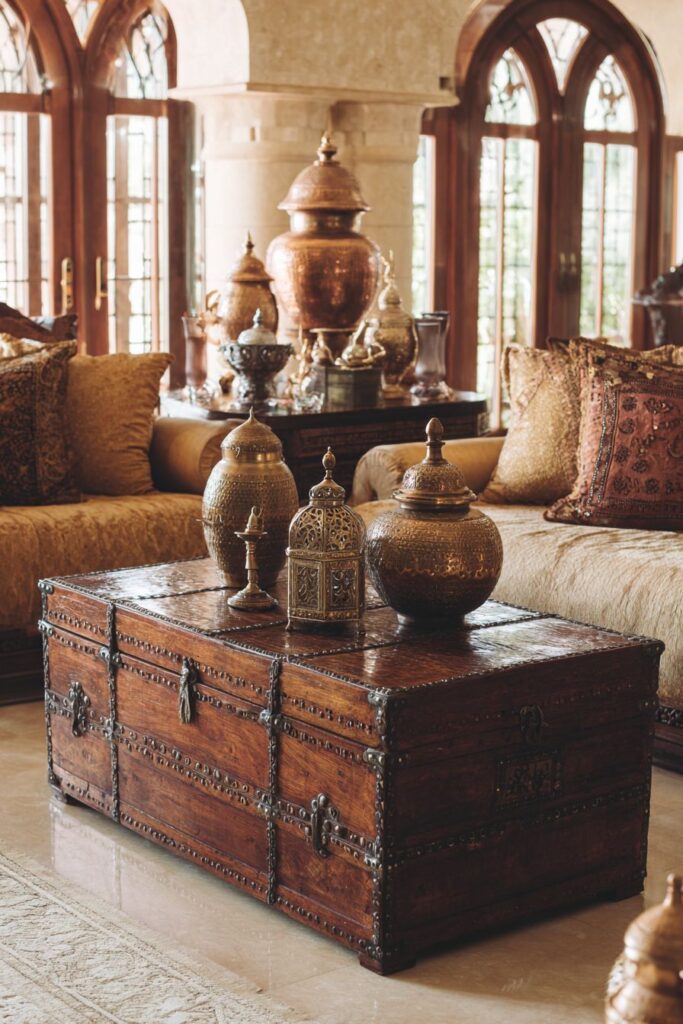
The chest’s rich patina and authentic wear patterns add character and authenticity that cannot be replicated in contemporary reproductions. Every scratch and mark represents years of use and care, connecting present-day living to the generations who treasured this piece before. The intricate carvings showcase traditional Arabic motifs, from geometric patterns to stylized floral designs, each element carefully placed to create overall visual harmony.

Traditional majlis seating arrangements with hand-embroidered cushions in silk and velvet create comfortable gathering spaces that honor Middle Eastern hospitality traditions while providing luxurious comfort. The hand-embroidered details on these cushions represent hours of skilled needlework, creating patterns that complement the chest’s carved motifs while adding color and textural variety. The combination of silk and velvet provides both visual and tactile luxury that invites relaxation and conversation.
Throughout the space, decorative copper and brass vessels of various sizes create displays that reflect warm ambient light from traditional oil lamps, creating an atmosphere reminiscent of ancient gathering places. These metalwork pieces, carefully selected for their authentic patina and traditional forms, serve both decorative and functional purposes while reinforcing the cultural authenticity of the overall design approach.

Key Design Tips:
- Select antique wooden chests with authentic patina and carving details as central furniture pieces
- Choose hand-embroidered cushions that complement rather than compete with carved furniture details
- Display copper and brass vessels in varied sizes to create visual interest and authentic atmosphere
- Use traditional oil lamps to provide warm ambient lighting that enhances metallic surfaces
- Position seating to take advantage of the central furniture piece while maintaining conversation flow
12. Architectural Iwans with Geometric Marble

Enter a living room that showcases traditional iwans—vaulted alcoves that represent one of the most sophisticated achievements in Islamic architecture. These architectural elements create intimate seating areas within the larger space while demonstrating the mathematical precision and artistic vision that characterizes the finest Arabic building traditions. The vaulted forms provide both acoustic benefits and visual drama, creating spaces within spaces that offer varying degrees of privacy and intimacy.
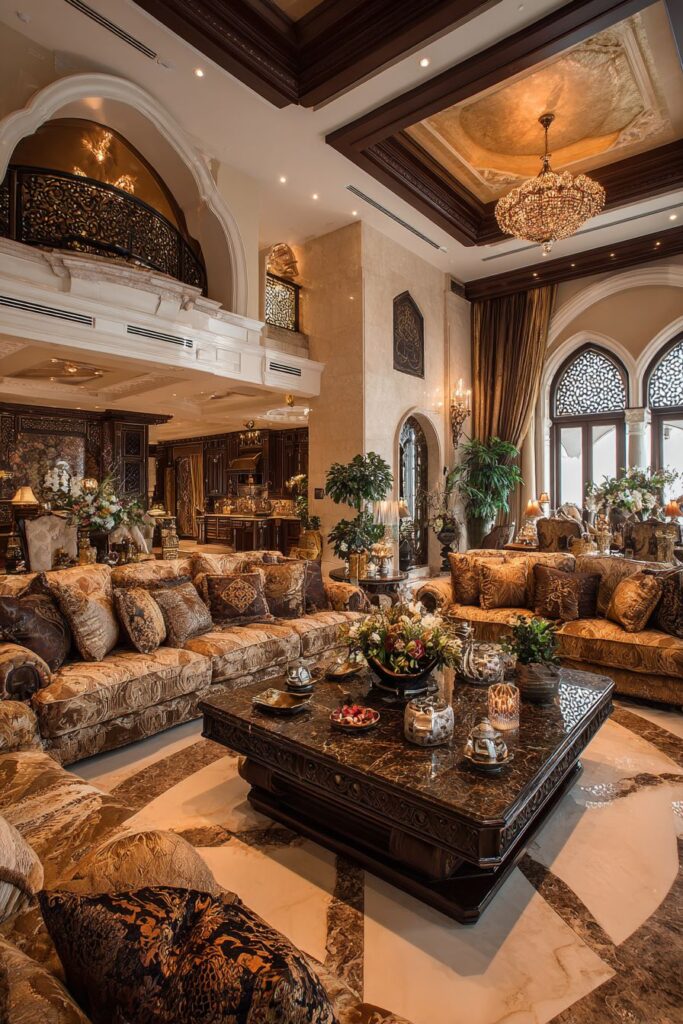
Built-in seating within these architectural alcoves features upholstery in rich brocade fabrics displaying classic Arabic patterns that have been refined over centuries. These patterns, whether geometric or stylized floral, follow traditional design principles while providing visual richness that complements the architectural grandeur. The brocade fabrics chosen for their durability and authentic appearance will develop character over time while maintaining their beauty and cultural significance.

The floor showcases beautiful geometric marble inlay work executed in traditional Islamic designs that demonstrate incredible precision and artistic vision. Each piece of marble has been carefully cut and fitted to create complex patterns that seem to extend infinitely in all directions. This flooring represents one of the most permanent and impressive ways to incorporate Islamic geometric principles into residential design, creating surfaces that will maintain their beauty for generations.
Ornate wooden screens with mother-of-pearl inlays serve as decorative room dividers that add privacy and visual interest while showcasing traditional Arabic decorative arts. These screens filter light while creating beautiful shadow patterns, and their mother-of-pearl inlays catch and reflect light to create subtle sparkle throughout the day. The combination of wood and mother-of-pearl represents the highest levels of traditional craftsmanship.
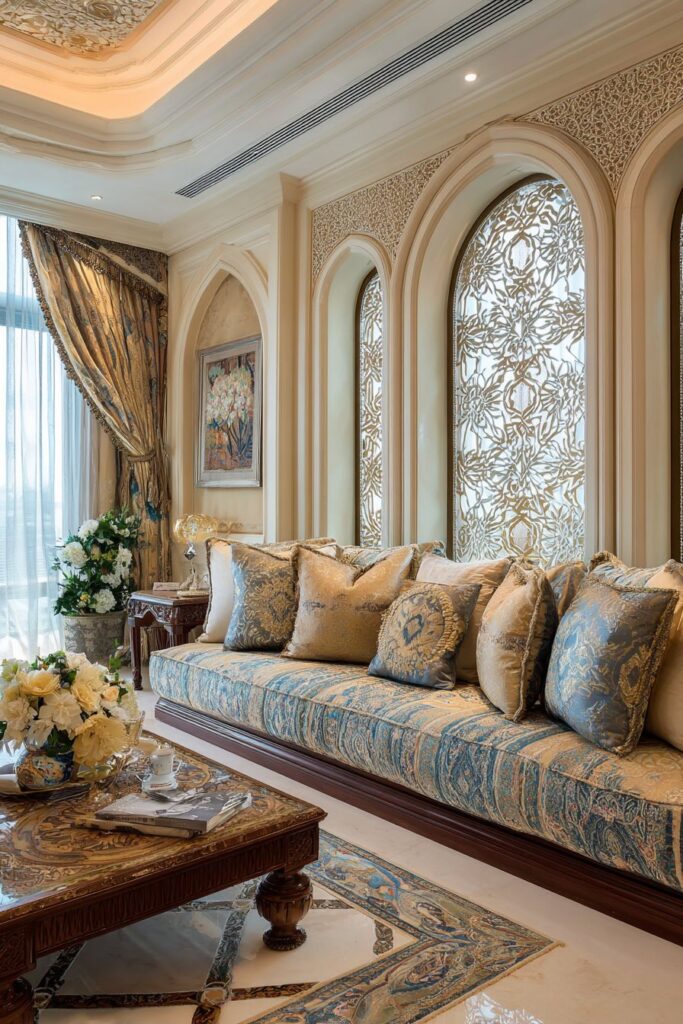
Key Design Tips:
- Incorporate architectural iwans to create intimate seating areas with dramatic vaulted ceilings
- Choose rich brocade fabrics with traditional patterns for built-in seating upholstery
- Install geometric marble inlay flooring to create permanent artistic foundations
- Use wooden screens with mother-of-pearl inlays as functional room dividers that add decorative value
- Position lighting to highlight both architectural details and decorative screen work
13. Arabic Calligraphy Art Gallery

Step into a living room that functions as a gallery for traditional Arabic calligraphy artwork, where the written word becomes artistic expression through centuries-refined techniques and spiritual significance. Each piece of calligraphy displayed in ornate frames above low seating areas represents not only artistic achievement but also cultural and spiritual expression, connecting modern living spaces to the deep literary and religious traditions of Arabic culture. The flowing lines and geometric precision of Arabic script create visual rhythm and movement that adds dynamic energy to the space.
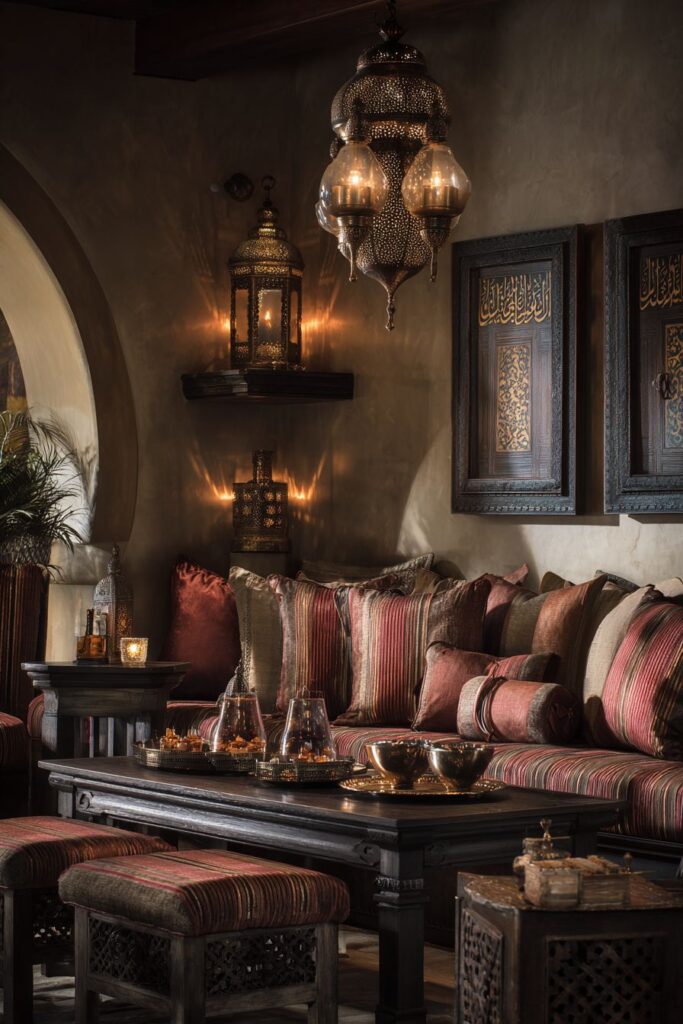
The calligraphy collection showcases various scripts and styles, from the flowing curves of Naskh to the angular precision of Kufic, each chosen for both artistic merit and meaningful content. These pieces serve as windows into Arabic literary and spiritual traditions while functioning as sophisticated wall art that provides visual interest and cultural education. The varying sizes and formats of the framed pieces create gallery-wall compositions that draw the eye and encourage closer examination.

Below this inspiring display, low seating areas feature silk cushions in jewel tones that echo the precious illuminated manuscripts tradition, where text and decoration combined to create objects of extraordinary beauty. These cushions, in sapphire blues, emerald greens, and ruby reds, provide luxurious comfort while maintaining color relationships that complement the framed artwork above. The silk fabric adds subtle sheen that catches and reflects light, creating visual connection to the metallic elements in the calligraphy frames.
The centerpiece lighting comes from a large ornamental brass chandelier with glass pendants that serves as both functional illumination and artistic statement. This magnificent fixture casts warm light across the hand-woven textiles while creating dramatic shadows and highlights that emphasize the three-dimensional qualities of the Arabic script. The brass metalwork and glass pendants echo traditional Islamic decorative arts while providing practical lighting for reading and conversation.

Key Design Tips:
- Create gallery walls with Arabic calligraphy in various scripts and sizes for cultural and artistic impact
- Choose silk cushions in jewel tones that complement framed artwork while providing luxurious seating
- Install ornate brass chandeliers with glass pendants for dramatic lighting that highlights textile details
- Display traditional perfume bottles and incense holders to engage multiple senses
- Position artwork at appropriate heights for viewing from low seating arrangements
14. Nomadic Bedouin-Inspired Adventure
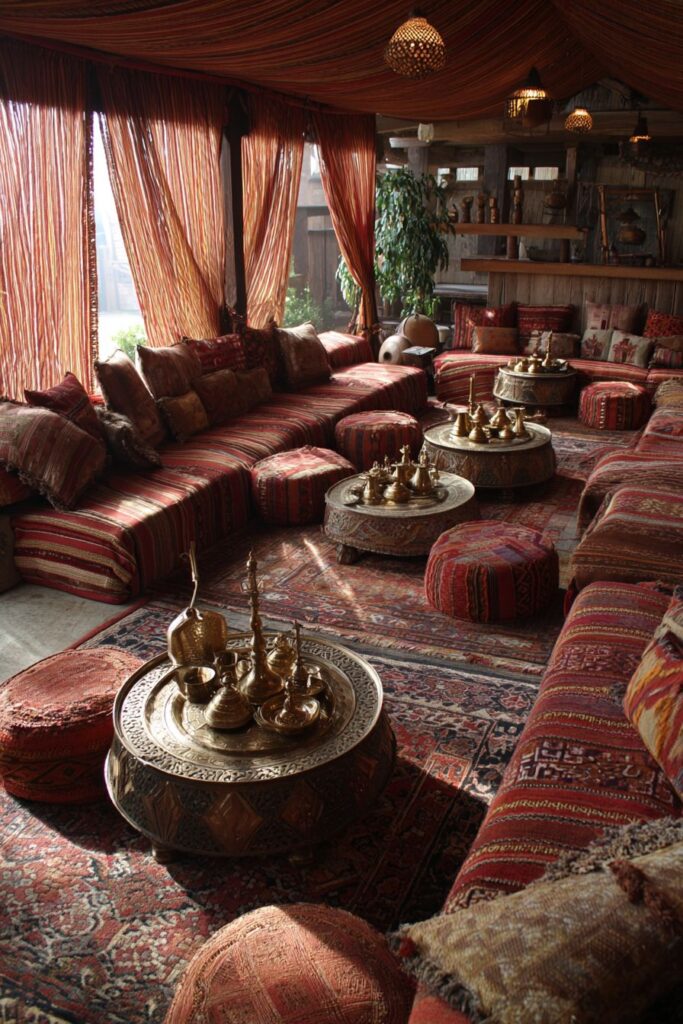
Journey into a living room that captures the authentic spirit of nomadic Bedouin culture through carefully layered Persian rugs and traditional seating arrangements using colorful floor cushions and bolsters. This design approach celebrates the portable luxury of desert peoples, where every element could be packed and moved as communities followed seasonal patterns. The layered rugs create rich tapestries of color and pattern while providing practical benefits of insulation and comfort on hard floor surfaces.
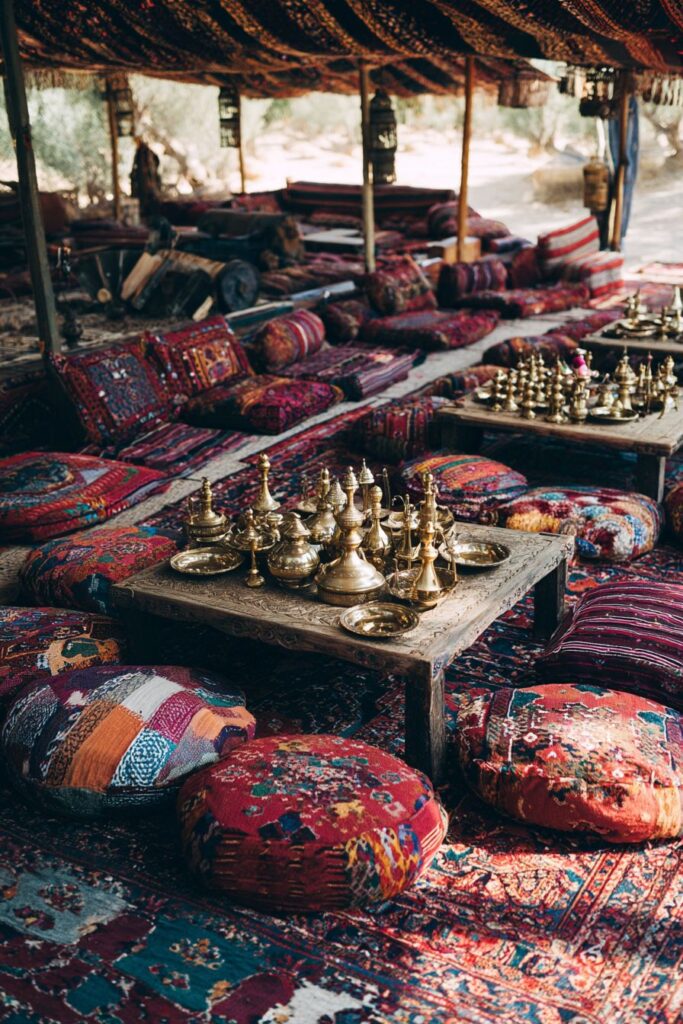
The Bedouin-style seating arrangements using floor cushions and bolsters honor traditions where furniture needed to be lightweight and portable while still providing comfort for extended periods of sitting and reclining. These seating elements, in vibrant colors and authentic patterns, create intimate conversation circles that encourage the storytelling and social interaction central to Bedouin culture. The low seating arrangement brings people closer together both physically and socially.
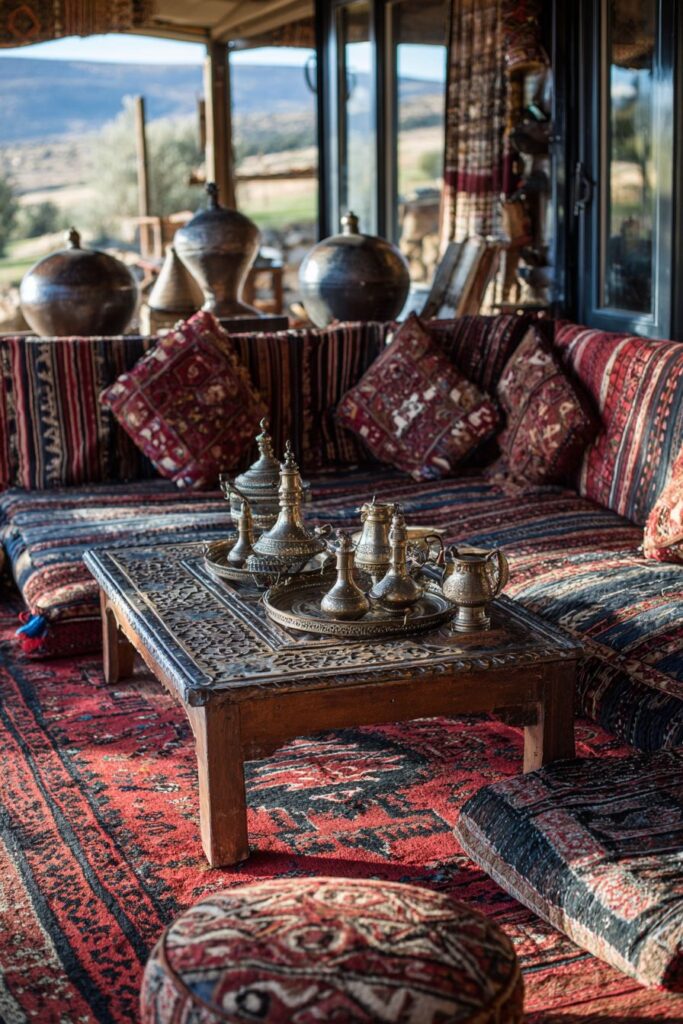
Vintage brass and silver coffee service sets displayed on low carved tables represent the central role of hospitality in desert cultures, where offering coffee and tea to guests was both practical necessity and sacred obligation. These service sets, carefully selected for their authentic forms and traditional decorative details, provide both functional utility and visual beauty while connecting modern entertaining to ancient hospitality traditions.
Traditional musical instruments and pottery create authentic decorative vignettes that tell stories of nomadic life and cultural heritage. These carefully curated displays include items that would have been found in actual Bedouin encampments, from drums and flutes to water vessels and cooking pots. Each piece adds authenticity while serving as conversation starter and cultural education opportunity.

Key Design Tips:
- Layer multiple Persian rugs to create rich floor covering that defines seating and activity areas
- Use colorful floor cushions and bolsters for authentic nomadic seating that encourages social interaction
- Display vintage coffee service sets on low tables to honor Middle Eastern hospitality traditions
- Create vignettes with musical instruments and pottery that tell stories of nomadic heritage
- Choose portable elements that could theoretically be moved, honoring Bedouin lifestyle principles
15. Central Fountain Tranquility
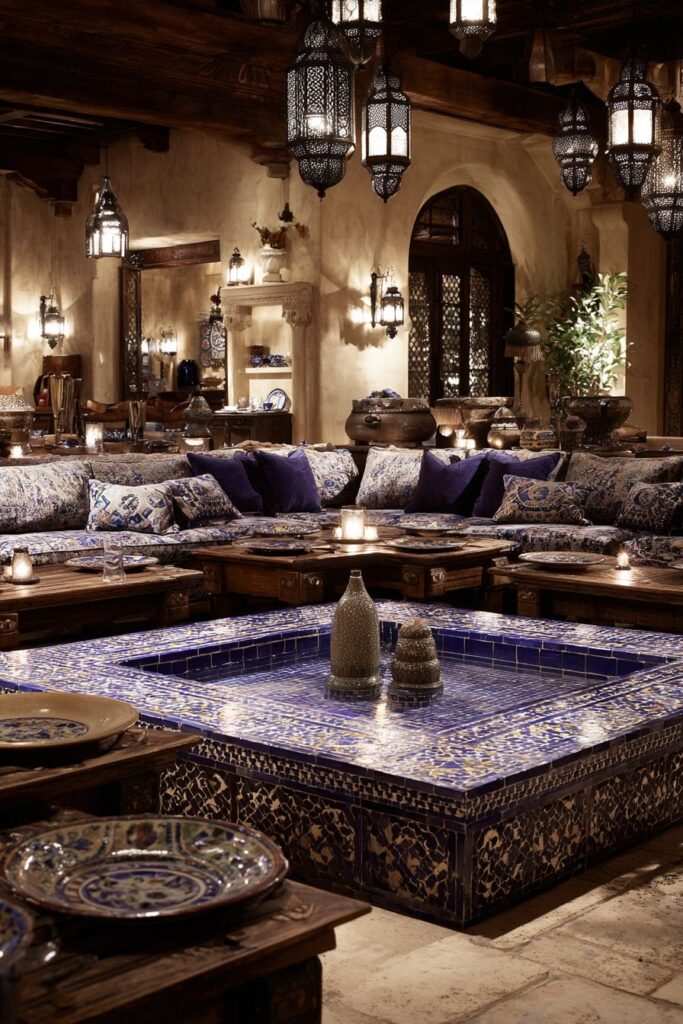
Enter a living room designed around the serene beauty of a magnificent tile fountain that serves as the central feature and spiritual heart of the space. This water feature connects to ancient Arabic architectural traditions where fountains provided both practical cooling and spiritual symbolism, representing the rivers of paradise described in Islamic texts. The gentle sound of flowing water creates a natural white noise that encourages relaxation and conversation while providing constant sensory pleasure.

Surrounding this tranquil centerpiece, traditional U-shaped seating with ornate wooden frames and rich upholstery creates intimate conversation areas where guests can enjoy both the visual and auditory pleasures of the fountain. The wooden frames showcase intricate carving details that complement the geometric patterns often found in traditional fountain tilework, while the rich upholstery provides luxurious comfort in colors carefully selected to harmonize with the tile and water elements.
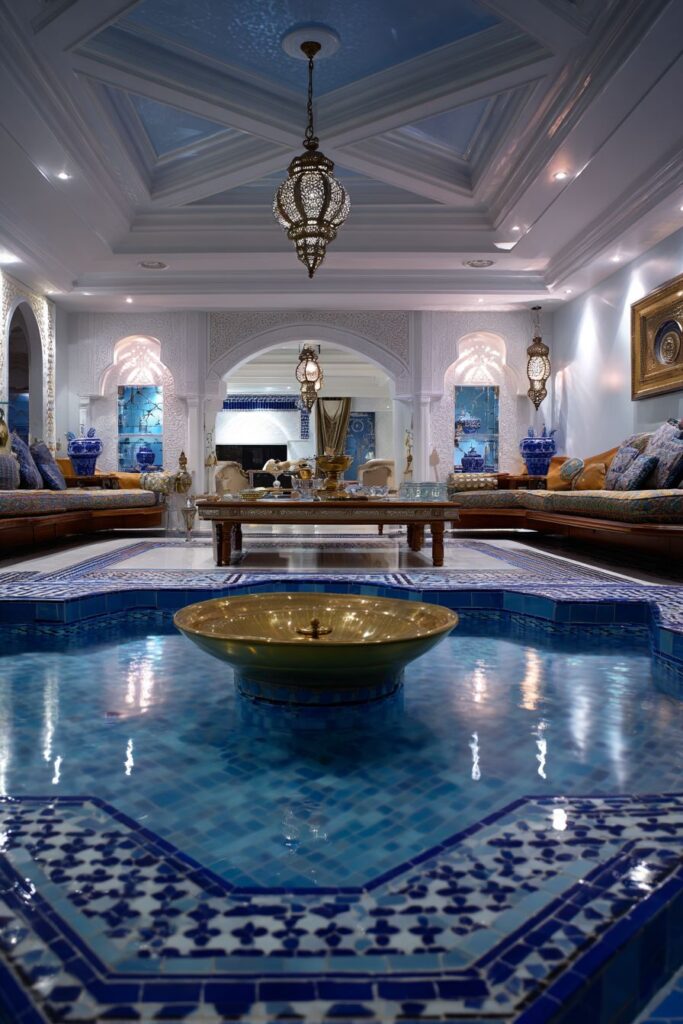
Hand-painted ceramic dishes and traditional Arabic serving pieces displayed in built-in niches create curated collections that add cultural depth and visual interest throughout the space. These carefully selected pieces represent various regional traditions within Arabic ceramic arts, from the blue and white traditions of certain regions to the rich earth tones and geometric patterns of others. Each piece tells stories of local customs and artistic traditions.
Decorative glass lanterns in various sizes hang at different heights throughout the space, creating layered lighting effects that change throughout the day as natural light levels fluctuate. These lanterns, with their colored glass and metal framework, cast beautiful patterns of light and shadow while providing both ambient and task lighting. The varying heights create visual rhythm and movement that complements the gentle motion of the fountain water.
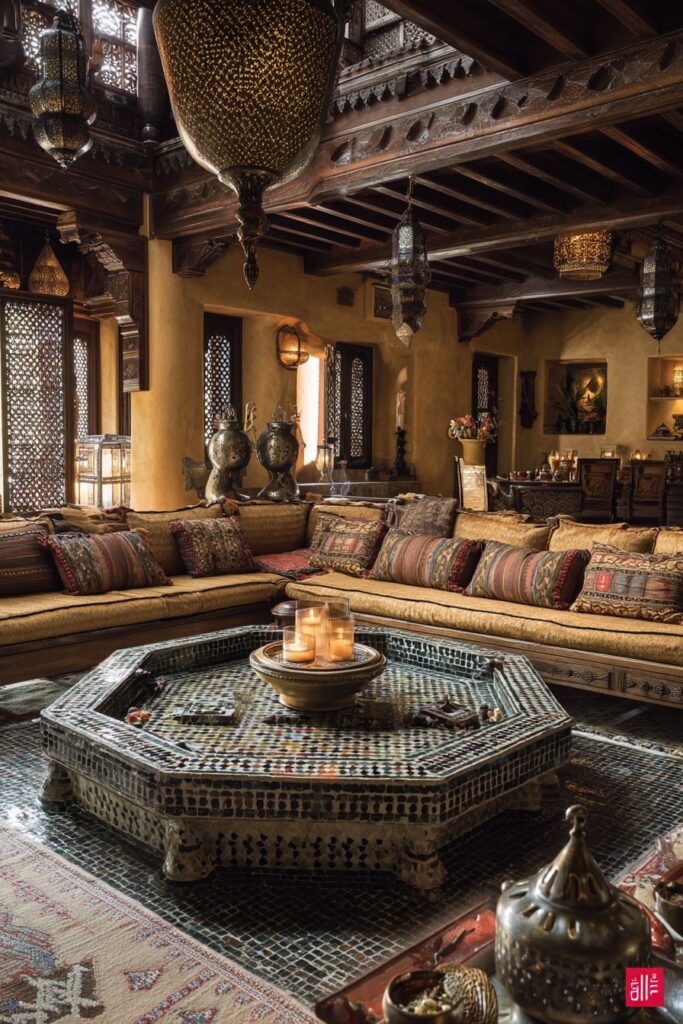
Key Design Tips:
- Install central tile fountains to provide both visual focus and soothing background sounds
- Arrange U-shaped seating around water features to maximize enjoyment and conversation opportunities
- Display hand-painted ceramics in built-in niches to create curated cultural collections
- Use glass lanterns at varying heights to create layered lighting effects throughout the space
- Choose colors and materials that complement water elements and enhance tranquil atmosphere
16. Moucharabieh Light Filtering Magic
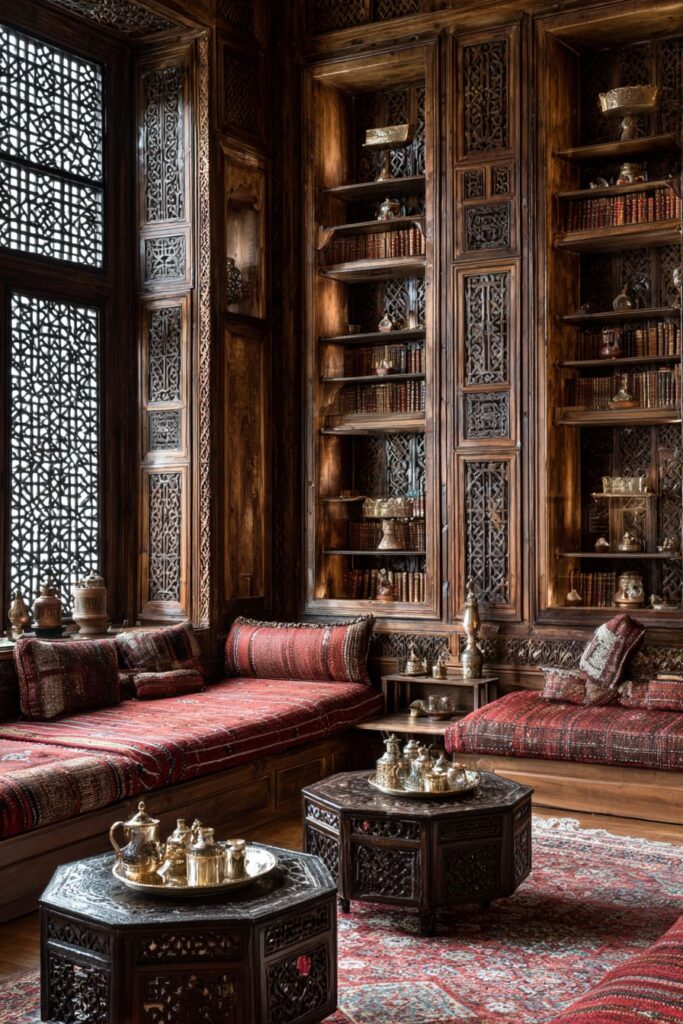
Discover a living room transformed by traditional moucharabieh wooden lattice windows that filter natural light into mesmerizing geometric patterns across Persian rugs and seating areas. These architectural marvels represent one of the most sophisticated solutions to climate control and privacy in traditional Arabic architecture, where intricate woodwork provides cooling, light control, and visual beauty simultaneously. The geometric patterns created by shadows change throughout the day, creating an ever-shifting display of light and shadow that keeps the space visually dynamic.
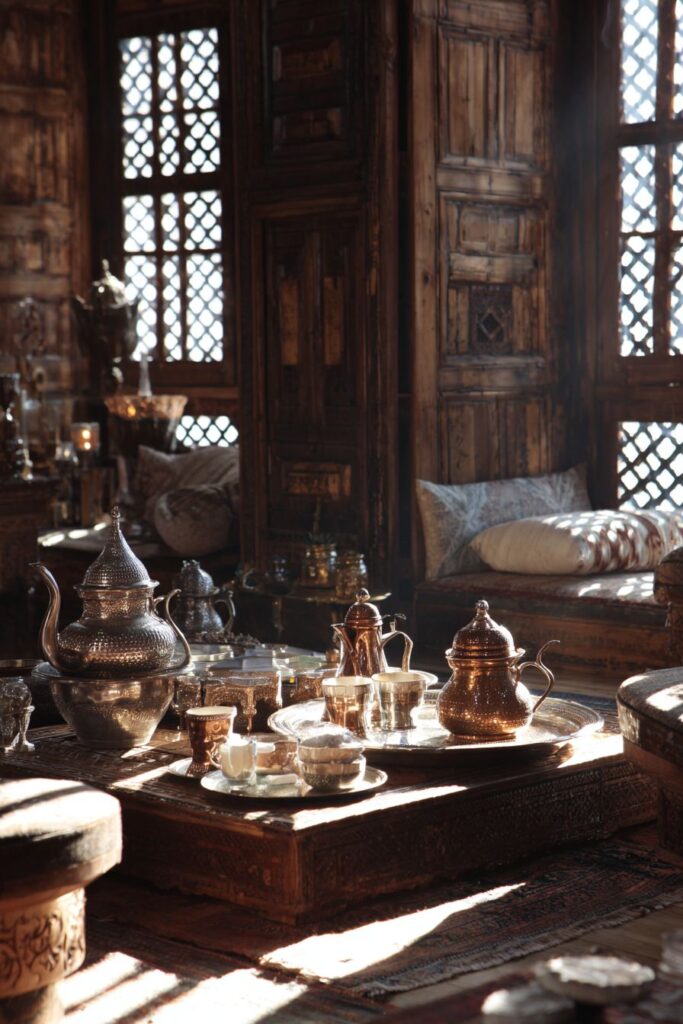
The moucharabieh screens not only provide practical benefits but also create one of the most beautiful aspects of traditional Arabic interior design—the interplay of light and shadow that brings geometric patterns to life on floors and walls. As the sun moves across the sky, these patterns shift and change, creating natural entertainment and visual interest that connects interior spaces to the rhythm of natural time cycles.
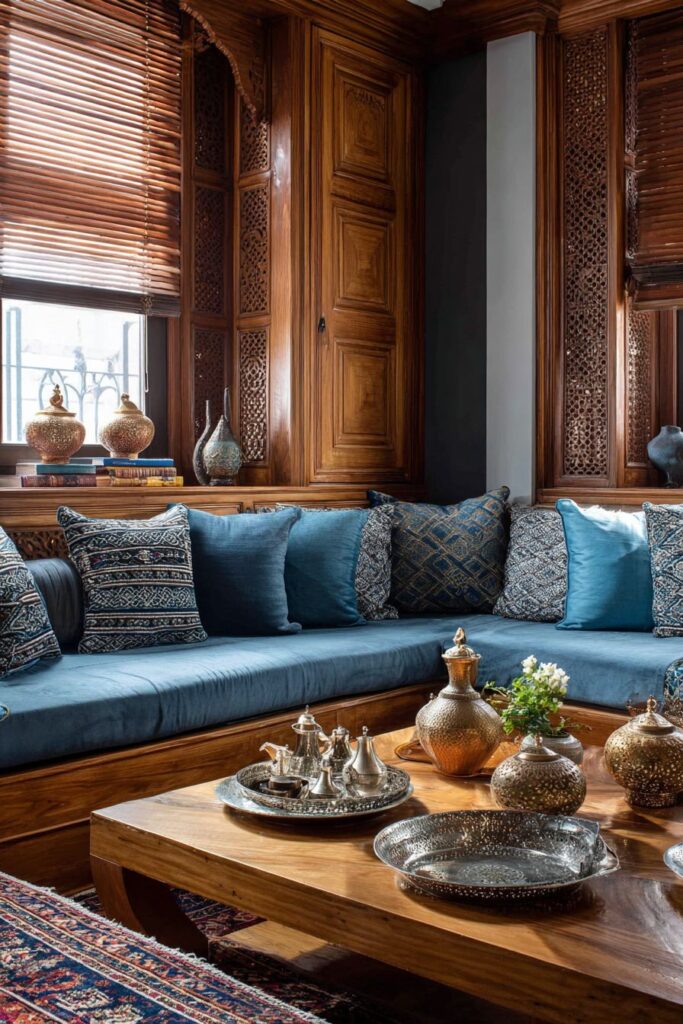
Within this enchanted environment, antique Arabic manuscripts and poetry books displayed in carved wooden bookcases alongside decorative ceramics create intellectual and cultural depth. These literary treasures, whether original historical documents or high-quality reproductions, connect the space to the rich intellectual traditions of Arabic culture while providing visual interest through their varied sizes, bindings, and calligraphic elements.
Traditional copper and silver tea service sets arranged on low tables with mother-of-pearl inlay details provide both functional utility and authentic cultural expression. These service sets represent the central importance of hospitality in Arabic culture, where offering tea to guests is both practical refreshment and symbolic gesture of welcome and friendship.

Key Design Tips:
- Install moucharabieh screens at windows to create dramatic light filtering effects and shadow patterns
- Position Persian rugs to showcase the geometric shadow patterns created by lattice windows
- Display Arabic manuscripts and books to add intellectual depth and cultural significance
- Use copper and silver tea services on mother-of-pearl inlay tables for authentic hospitality elements
- Arrange seating to take advantage of changing light patterns throughout the day
17. Dramatic Tent Ceiling Treatment

Enter a living room where traditional tent ceiling treatment creates an intimate canopy effect through draped fabrics in rich burgundy and gold that transform ordinary architecture into something magical and exotic. This dramatic overhead treatment draws inspiration from luxury Bedouin encampments, where fabric architecture created portable palaces that could be assembled and disassembled as communities moved across desert landscapes. The rich colors create a sense of enclosure and intimacy that makes large spaces feel more human-scaled and comfortable.
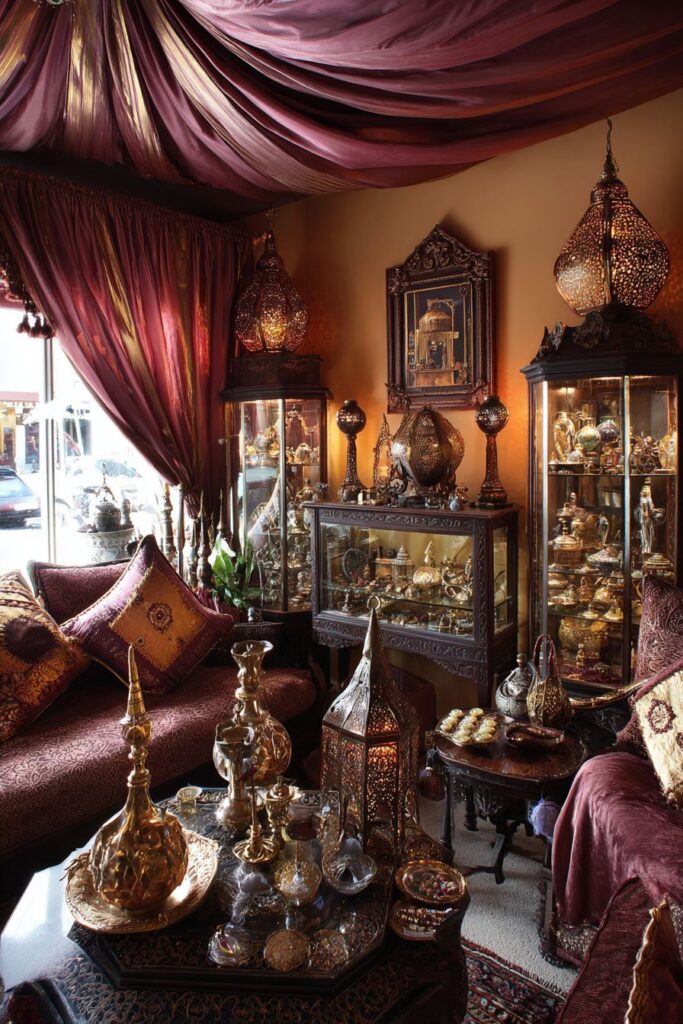
The burgundy and gold color combination chosen for the ceiling treatment represents traditional Arabic luxury, with burgundy symbolizing nobility and gold representing divine light and prosperity. These rich colors create depth and warmth overhead while providing a dramatic backdrop for all other design elements in the room. The tent-like effect psychologically lowers the ceiling height, creating cozy intimacy within larger architectural spaces.

Below this dramatic canopy, ornate floor lamps with pierced metal shades provide ambient lighting alongside traditional oil lamps, creating multiple layers of illumination that can be adjusted for different activities and moods. The pierced metal work in these lamps creates additional pattern and shadow play that complements the tent ceiling while providing practical task and ambient lighting. Traditional oil lamps add authentic atmosphere and romantic flickering light.
Throughout the space, vintage Arabic coins, jewelry, and decorative objects displayed in glass cases and on carved shelves create treasure-like collections that add personal interest and cultural education opportunities. These authentic artifacts, whether family heirlooms or carefully selected antiques, tell stories of Arabic cultural heritage while providing intimate scale decorative elements that invite closer examination.

Key Design Tips:
- Create tent ceiling effects with draped fabrics in rich colors to add drama and intimacy
- Use burgundy and gold combinations for traditional Arabic luxury color schemes
- Install multiple lighting layers including floor lamps and oil lamps for flexible illumination
- Display collections of authentic artifacts in glass cases for cultural education and personal interest
- Position carved shelving to showcase decorative objects while maintaining overall design coherence
18. Ceramic Vessel Collection Showcase
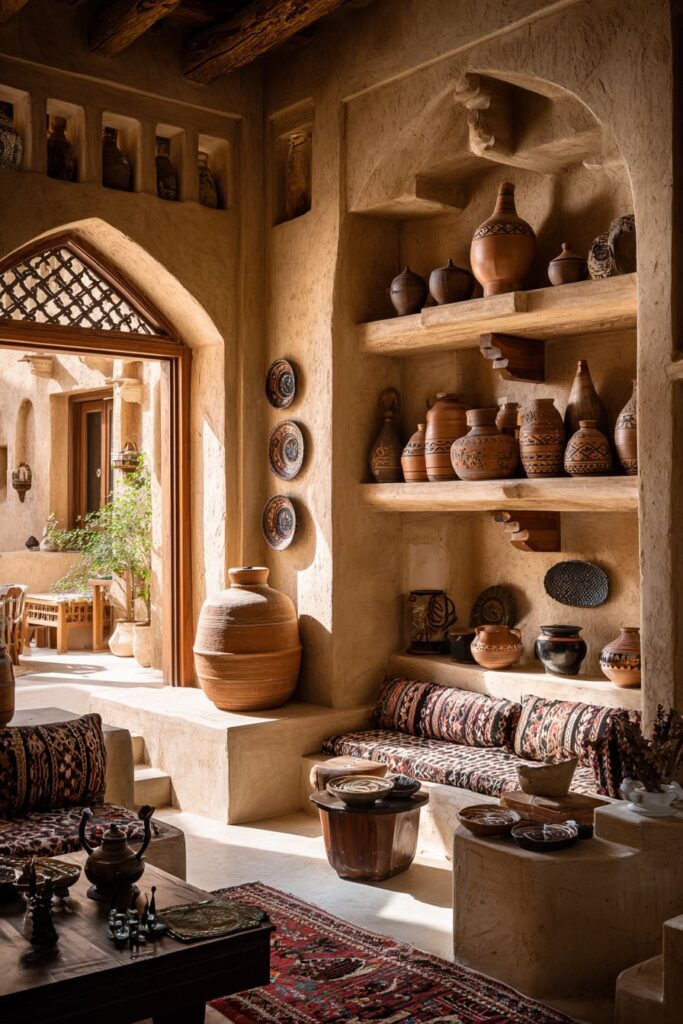
Step into a living room that celebrates the art of traditional Arabic ceramics through a striking collection of vessels and pottery displayed on built-in shelving with decorative brackets. This approach treats functional objects as art, showcasing the incredible diversity of ceramic traditions found throughout the Arabic world. Each piece represents specific regional techniques, from the lustrous glazes of Syrian pottery to the intricate geometric patterns of Moroccan ceramics. The built-in shelving system creates a museum-like display that allows each piece to be appreciated individually while contributing to an impressive collective presentation.
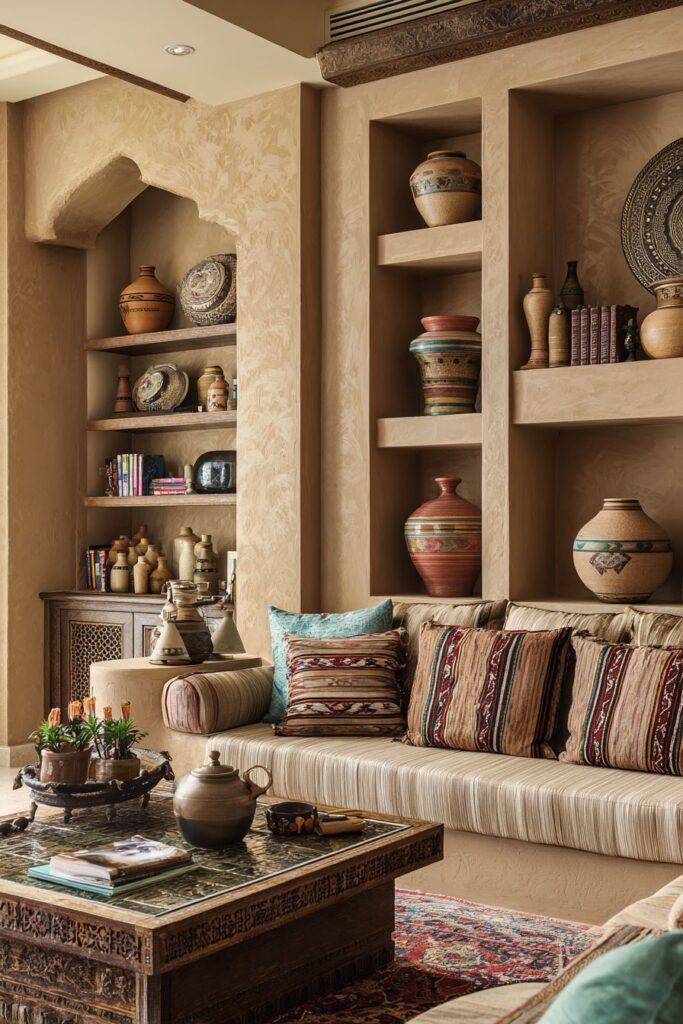
The decorative brackets supporting these displays showcase traditional metalwork techniques, adding another layer of authentic craftsmanship to the overall design. These brackets, whether cast in brass or forged in iron, feature patterns and details that complement the ceramic pieces they support while adding structural beauty to the wall system. The combination of ceramics and metalwork creates rich textural variety that engages viewers at multiple levels.
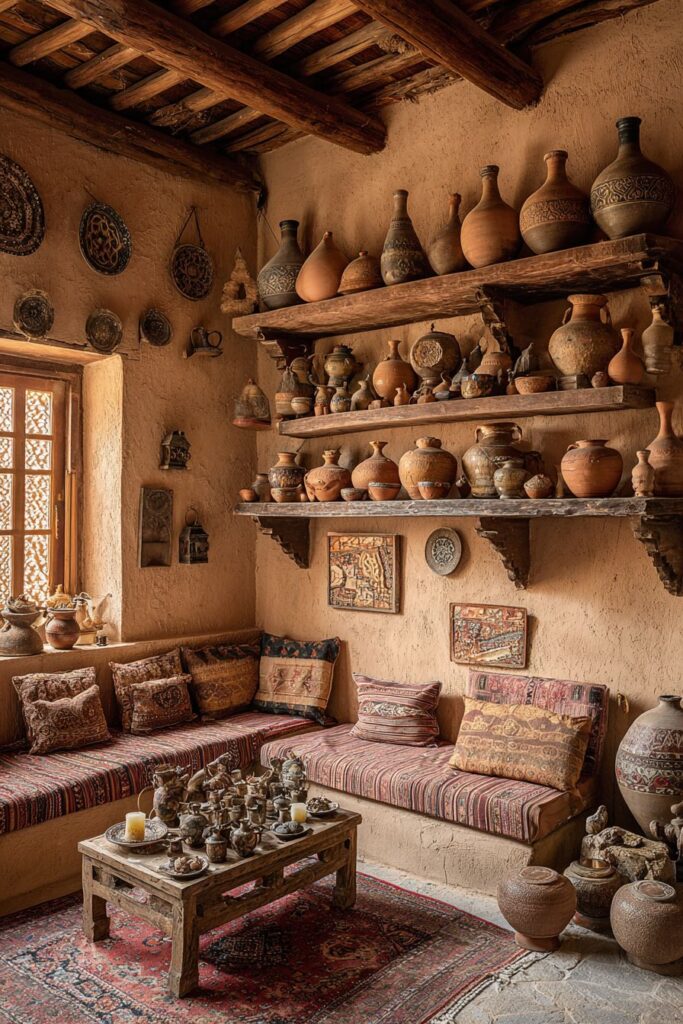
Low seating with hand-woven cushions in traditional patterns surrounds a central area enhanced by layered vintage rugs that create rich foundation for the room’s activities. The hand-woven cushions feature patterns that echo and complement the geometric designs found in the ceramic collection, creating visual harmony between seating and display elements. The layered rugs add additional pattern and texture while defining intimate conversation areas.
Ornate metalwork including decorative plates and serving trays adorns the walls as functional art, creating three-dimensional displays that cast interesting shadows while serving potential practical purposes. These pieces represent various metalwork traditions within Arabic decorative arts, from repousse techniques that create raised patterns to inlay work that combines different metals for contrasting effects.
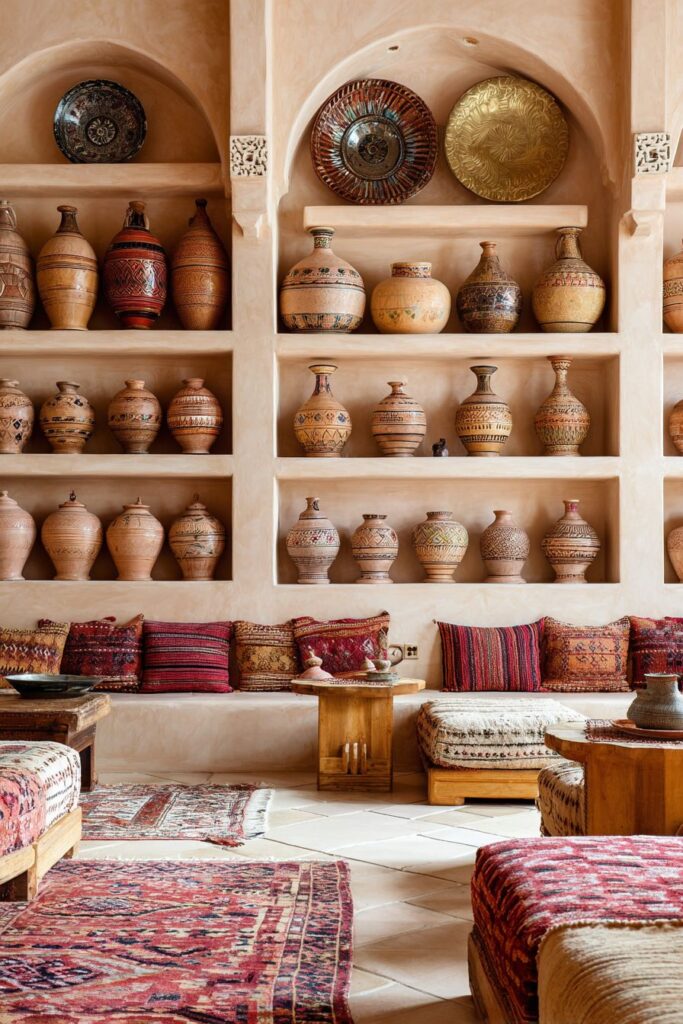
Key Design Tips:
- Install built-in shelving with decorative brackets to create museum-quality displays for ceramic collections
- Choose hand-woven cushions with patterns that complement rather than compete with ceramic designs
- Layer vintage rugs to create rich textural foundations that support but don’t overwhelm ceramic displays
- Use metalwork pieces as wall art that provides three-dimensional interest and authentic cultural elements
- Balance display density to allow individual pieces to be appreciated while creating impressive collective impact
19. Historical Architectural Elements
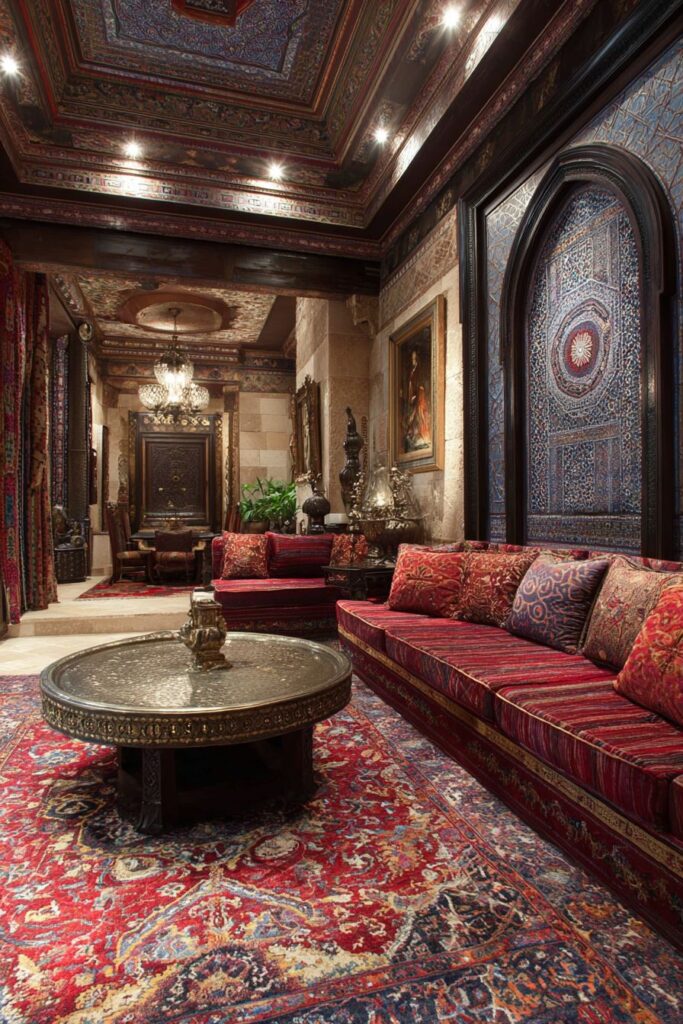
Enter a living room that showcases traditional architectural elements including pointed arch doorways and decorative plaster moldings featuring Islamic geometric patterns that transform ordinary residential spaces into palatial environments. These architectural details represent centuries of refined building traditions, where structural elements become opportunities for artistic expression. The pointed arches create dramatic sight lines and frame views throughout the space while their mathematical precision reflects the sophisticated engineering knowledge of traditional Arabic builders.
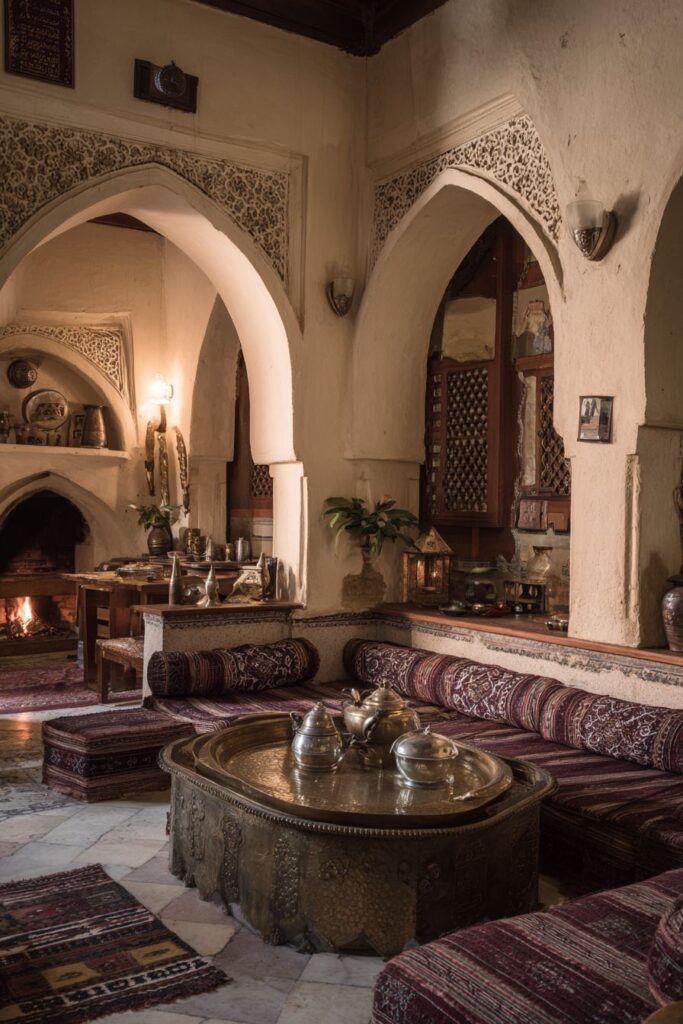
The decorative plaster moldings featuring Islamic geometric patterns add incredible visual richness to wall and ceiling surfaces, demonstrating the mathematical precision and artistic vision that characterizes the finest Arabic decorative arts. These three-dimensional patterns create complex plays of light and shadow that change throughout the day, providing constant visual interest and connection to the cosmic order represented by geometric repetition in Islamic art.

Comfortable banquette seating with embroidered silk cushions lines the walls beneath impressive displays of traditional Arabic weapons and armor that represent the martial heritage of Arabic culture. These historical artifacts, whether authentic antiques or high-quality reproductions, tell stories of craftsmanship traditions that extended beyond decorative arts into functional objects of incredible beauty and technical sophistication.
A central brazier-style table with brass details serves as both functional furniture and cultural focal point, connecting modern living to ancient traditions where fire provided warmth, light, and gathering focus. This piece represents the adaptation of traditional forms to contemporary needs, maintaining cultural authenticity while providing practical utility for modern entertaining and daily living.
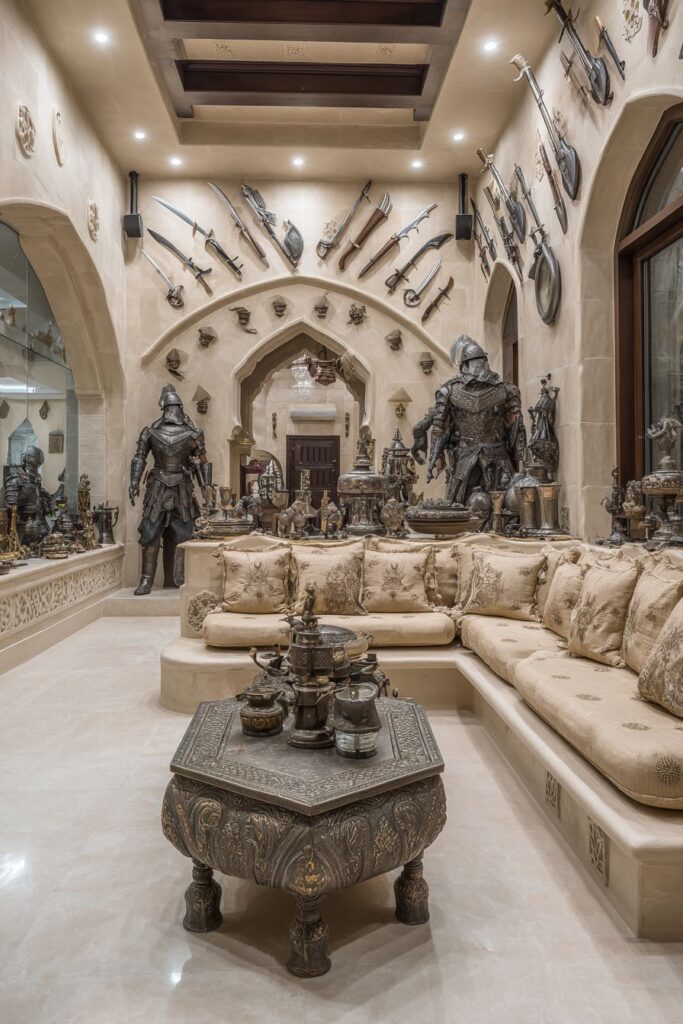
Key Design Tips:
- Install pointed arch doorways to create dramatic architectural focal points and frame different room areas
- Add decorative plaster moldings with geometric patterns for visual richness and authentic architectural details
- Display historical weapons and armor as cultural artifacts that add educational and personal interest
- Use brazier-style tables as central focal points that combine function with cultural authenticity
- Balance architectural grandeur with comfortable seating that maintains human scale and livability
20. Authentic Bedouin Fire Pit Gathering

Conclude this journey through Arabic living room design with an authentic Bedouin-style space that captures the essence of desert nomadic life through floor seating arrangements using colorful woven cushions and traditional camel saddle stools arranged around a central fire pit. This design honors the portable luxury of desert peoples, where every element served both practical and aesthetic purposes while being light enough to transport across vast landscapes.

The colorful woven cushions represent the textile traditions of various Bedouin tribes, where patterns and colors identified tribal affiliations while providing comfort during long desert evenings. These cushions, arranged in conversation circles around the fire pit, create intimate gathering spaces that encourage storytelling and social interaction central to nomadic culture. The low seating brings people closer to the ground and to each other, fostering intimacy and connection.
Vintage tribal rugs in rich earth tones layer across the floor, creating insulation and comfort while displaying the incredible artistic achievement of nomadic weavers who created masterpieces under the most challenging conditions. These rugs tell stories through their patterns, with each design element carrying meaning related to protection, prosperity, or spiritual beliefs. The earth tones connect interior spaces to the desert landscape that shaped nomadic culture.
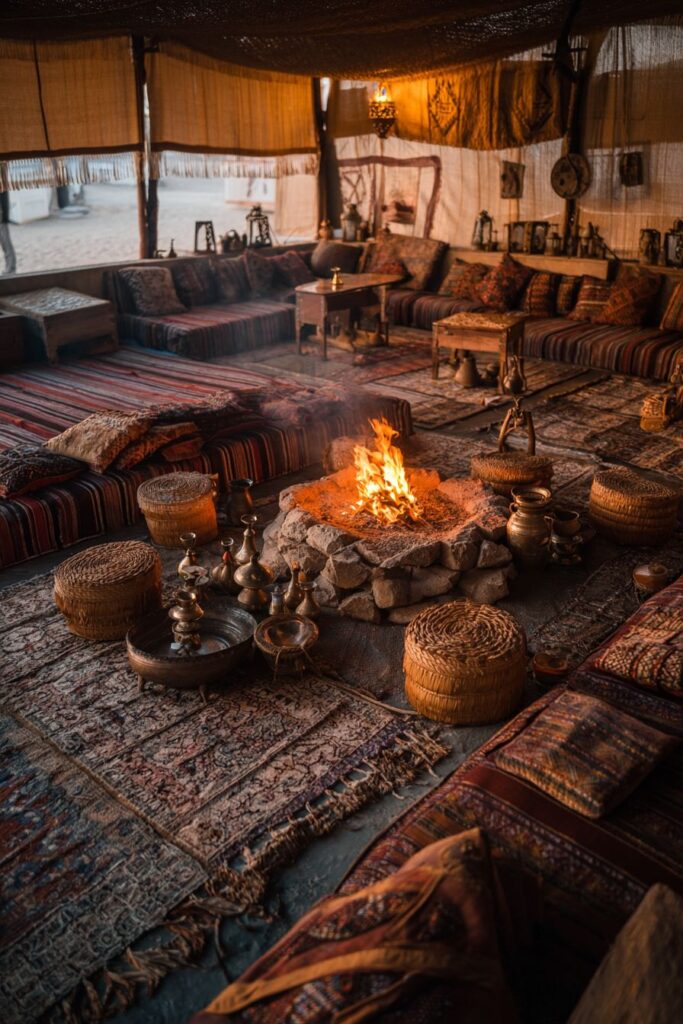
Traditional falconry equipment and desert artifacts create authentic decorative displays that educate viewers about the practical aspects of nomadic life while adding visual interest and cultural depth. These carefully selected pieces represent the skills and knowledge necessary for survival in harsh desert environments, from hunting techniques to water conservation and navigation.
Traditional leather and metal water vessels arranged alongside seating areas remind us of the paramount importance of water in desert cultures while serving as beautiful decorative elements. These vessels, crafted for both function and beauty, represent the nomadic principle that even the most utilitarian objects should please the eye and lift the spirit.

Key Design Tips:
- Arrange colorful floor cushions in conversation circles around central fire features for authentic nomadic gathering spaces
- Layer tribal rugs in earth tones to create comfortable foundations that connect to desert landscape origins
- Display falconry equipment and desert artifacts as educational elements that add cultural depth
- Position traditional water vessels as reminders of the practical origins of nomadic design principles
- Use golden hour lighting to create warm, romantic atmosphere that enhances authentic desert culture elements
Why These Arabic Living Room Designs Represent the Best in Middle Eastern Interior Design
These twenty Arabic living room designs represent the pinnacle of Middle Eastern interior design excellence because they successfully balance authentic cultural expression with contemporary livability. Each design demonstrates deep understanding of Arabic design principles while adapting these timeless concepts to modern lifestyle needs. The majlis seating arrangements honor traditional hospitality customs while providing comfortable gathering spaces for today’s families. The geometric patterns found in rugs, tiles, and architectural details connect spaces to mathematical principles that reflect cosmic order in Islamic philosophy.
The use of traditional materials like hand-carved wood, brass metalwork, and hand-woven textiles ensures authenticity while providing the durability and beauty that make these designs practical for long-term living. The incorporation of water features, from fountains to traditional vessels, connects modern spaces to ancient principles of environmental cooling and spiritual symbolism. The lighting approaches, from pierced metal lanterns to traditional oil lamps, create atmosphere while honoring cultural traditions.
These designs excel because they demonstrate how Arabic interior design principles can enhance contemporary living through their emphasis on hospitality, comfort, and beauty. The low seating arrangements encourage conversation and connection, while the rich colors and textures create environments that engage all the senses. The integration of calligraphy, ceramics, and metalwork adds cultural depth that transforms houses into homes with meaning and heritage.
Conclusion
Arabic living room design offers endless inspiration for creating spaces that celebrate cultural heritage while meeting contemporary needs. These twenty distinctive approaches demonstrate the incredible versatility and enduring appeal of Middle Eastern design principles, from traditional majlis arrangements to contemporary fusion concepts. Each design showcases how authentic materials, traditional patterns, and cultural elements can transform ordinary living spaces into extraordinary environments that honor the past while embracing the future.
The beauty of Arabic design lies in its ability to create intimate, hospitable spaces that encourage human connection and cultural appreciation. Whether incorporating a single statement piece like a hand-knotted carpet or undertaking complete architectural transformations with horseshoe arches and decorative plasterwork, these design principles offer pathways to creating living spaces with soul and significance. By understanding and applying these traditional concepts, homeowners can create Arabic living rooms that serve as both functional gathering spaces and cultural celebrations that will inspire and delight for generations to come.
